Best bike locks 2025: every style of lock extensively tested and rated
Our cycling experts put all the best bike locks through rigorous testing, ensuring you can leave your bike anywhere, secure in the knowledge that it's safe.
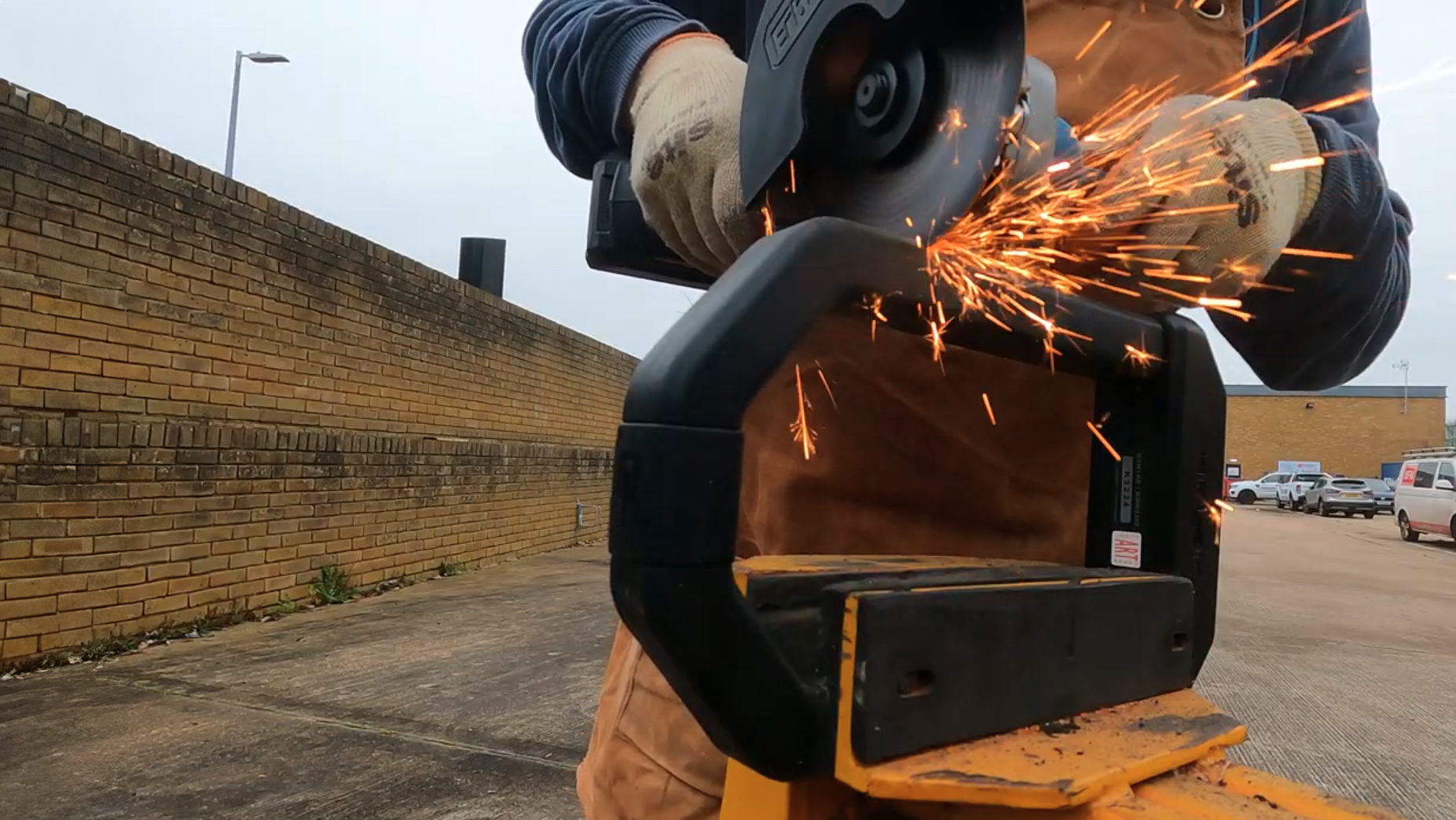
The best bike locks serve as a strong deterrent against thieves and are vital cycling accessories whether you intend to commute by bike or secure your pride and joy at home.
Here at Cycling Weekly, we have tested hundreds of bike locks over the years, including a dozen I personally tested in the last year. These range from high-security angle grinder-resistant bike locks and chain locks for securing bikes at home and at train stations to portable and lightweight bike locks for bikepacking and peace of mind during café stops.
We rigorously assess the usability, functionality, and features of every lock we test, only resorting to power tools for those that claim angle grinder resistance. In the UK and North America, Sold Secure handles the rest, while ART does so in Europe. These organizations independently test bicycle locks and categorize them using a straightforward rating system based on their performance. Our reviews include the security ratings. Please scroll to the bottom of this page for further information about a 'Sold Secure' rating and how I can ensure my bike lock is tough enough.
As I mentioned, there are various styles of bike locks, but our best overall choice is the OnGuard RockSolid for its angle grinder resistance, low weight, and exceptional value. Because there is such a wide range of options, careful consideration is required when purchasing a lock based on where and when you might need to use it. For tips on the best bike lock for you, check out our How To Choose section at the bottom of this page.
A reliable bike lock isn't the only way to secure your bike. Consider adding one of the best GPS bike trackers, which will significantly increase your chances of recovering it and always make sure you cover your bike with some of the best bicycle insurance.
Best bike locks: quick list
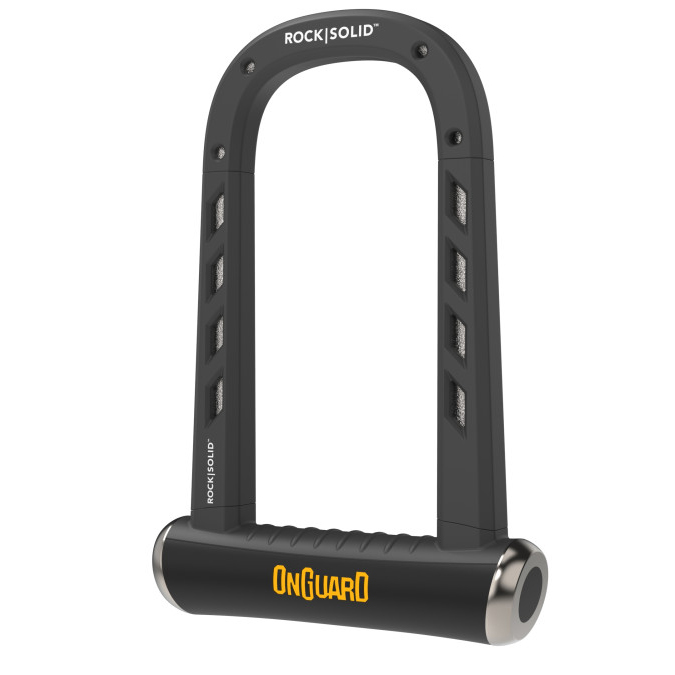
You won’t believe how light the RockSolid 8590 is—just 1.3kg/2.8 lbs—yet it’s incredibly secure! With a Sold Secure diamond rating, it outperforms angle grinder discs.
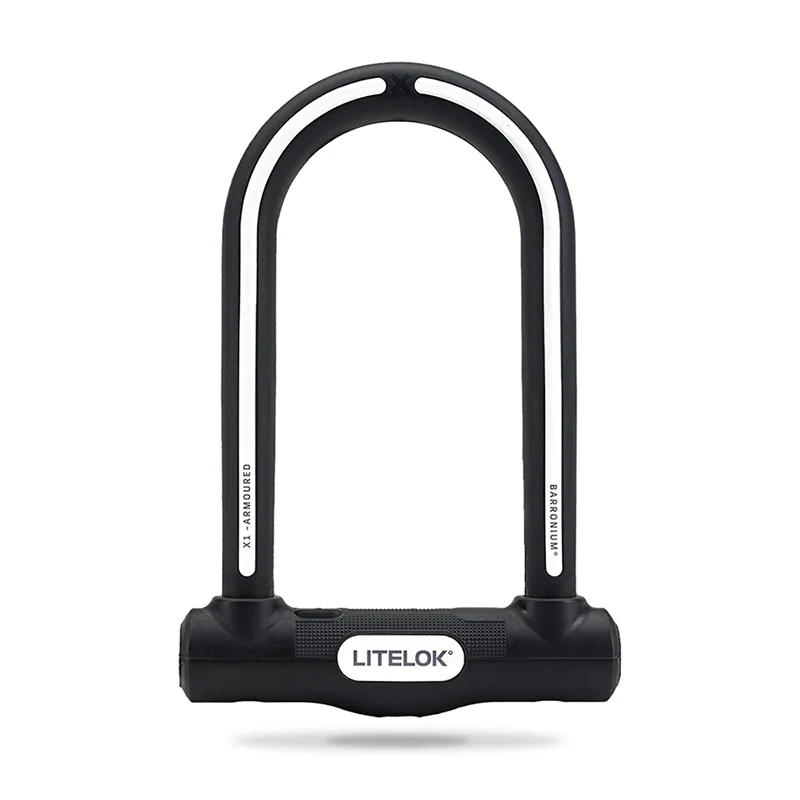
Now, inadvertently one of the cheapest angle grinder-proof locks on the market, the Litelok X1 still offers formidable security.
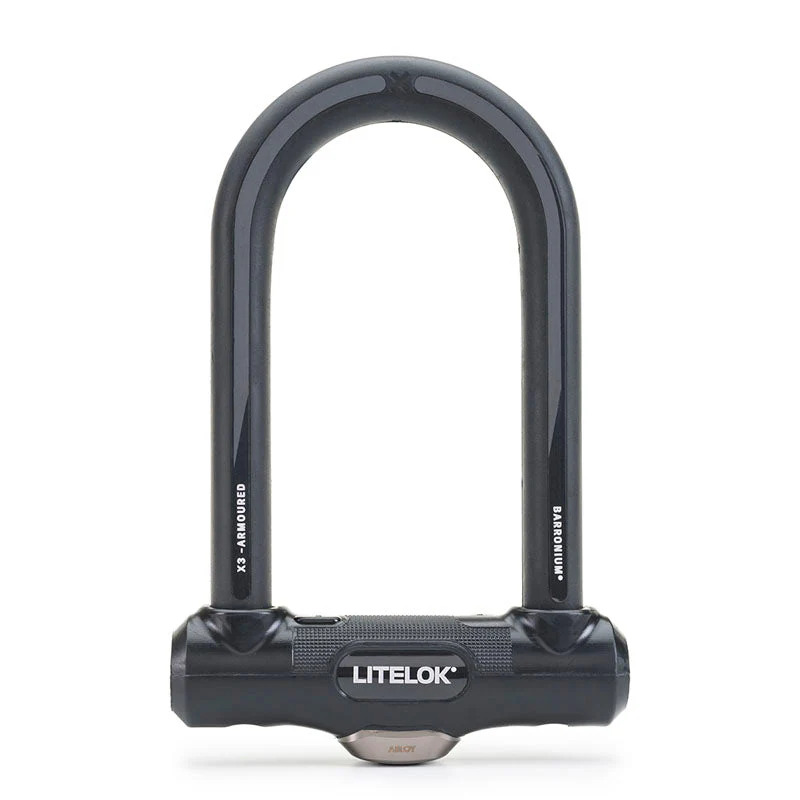
The LiteLok X3 and the OnGuard RockSolid are separated by very little. If you need the greater flexibility of a longer shackle, there is really one way to go, and thats with the X3.
Load 3 more top-rated u-locks
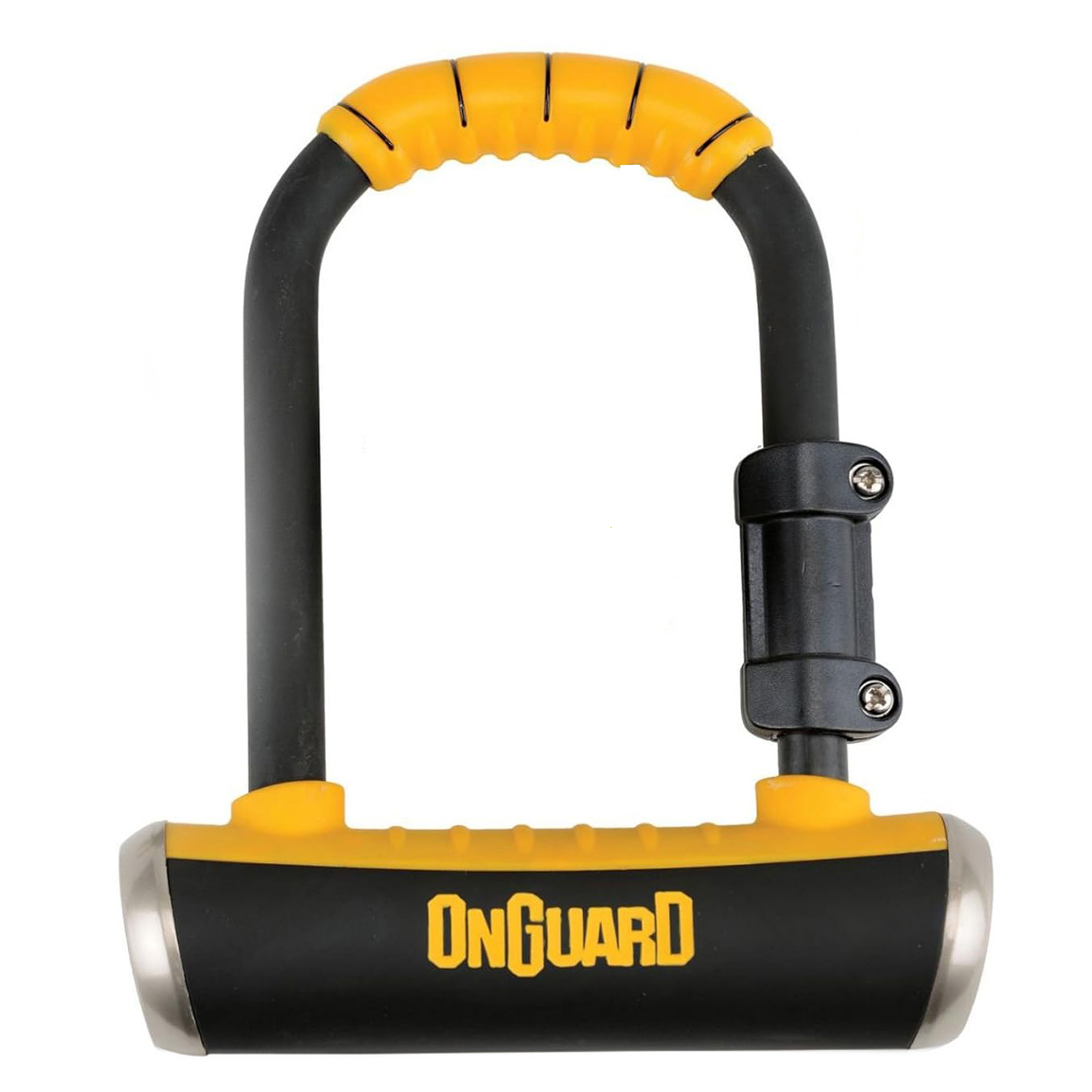
The Onguard 8006 Pitbull Mini is an obsolete bargain for a Sold Secure Diamond rated and just about the lowest price lock with his rating.
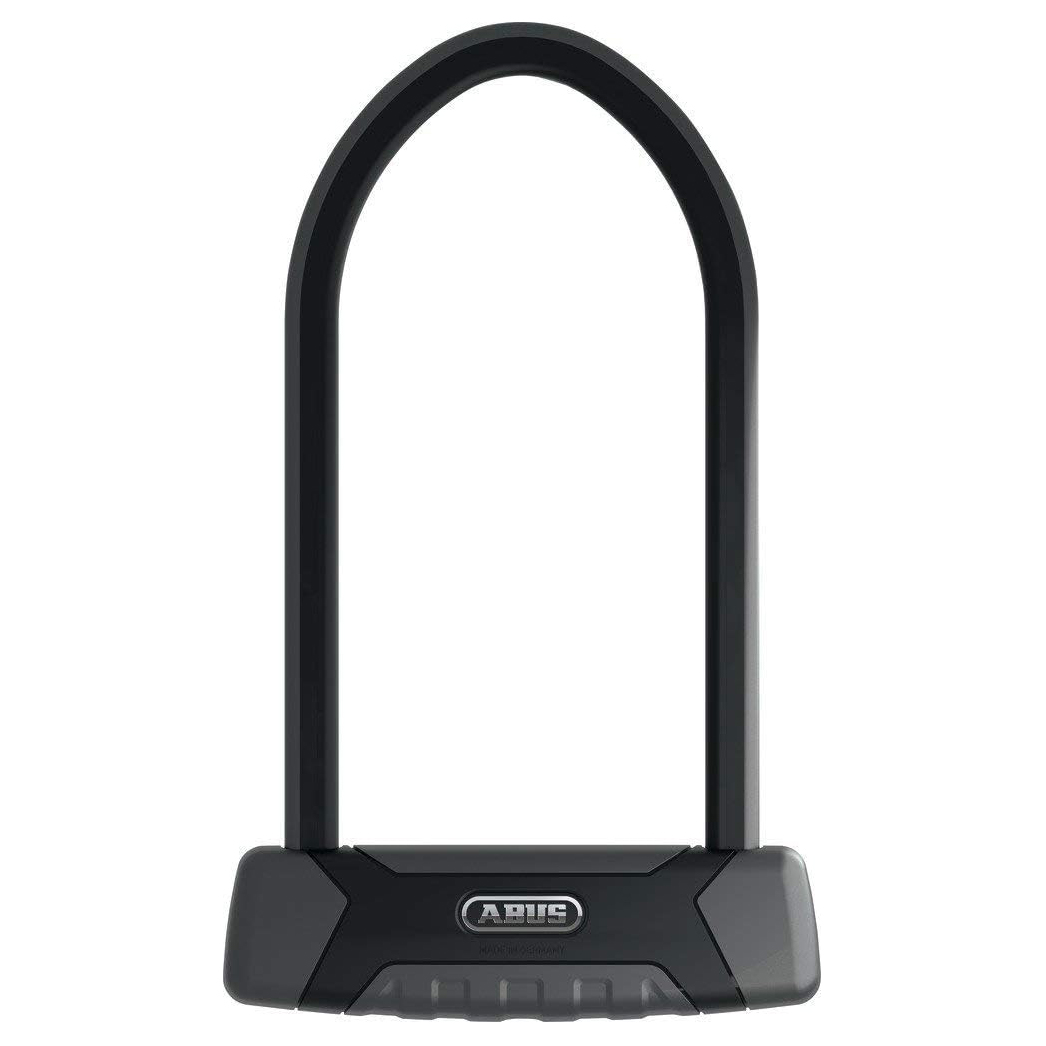
The Granit X Plus 540 from Abus does an incredible job of balancing security with reach and overall weight. It is only let down by its slightly higher cost versus its competitors.
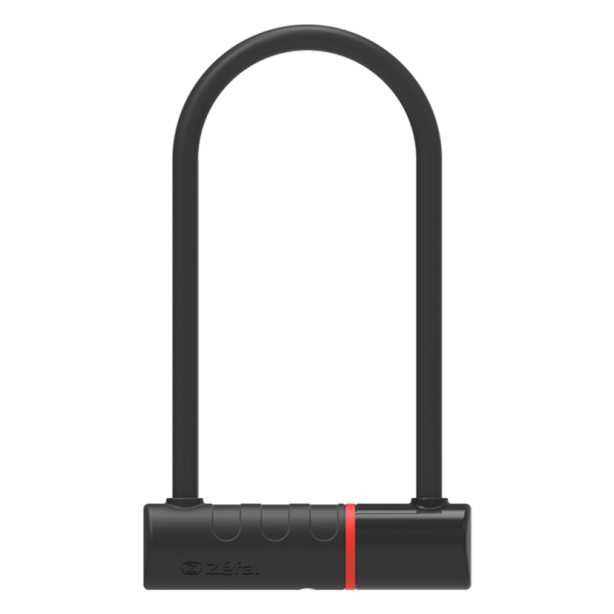
If you are just looking for a cheap bike lock, look no further than the Zéfal K-Traz U17. It might be cheap, but that doesn't mean it isn't secure; it boasts a Sold Secure Gold rating.
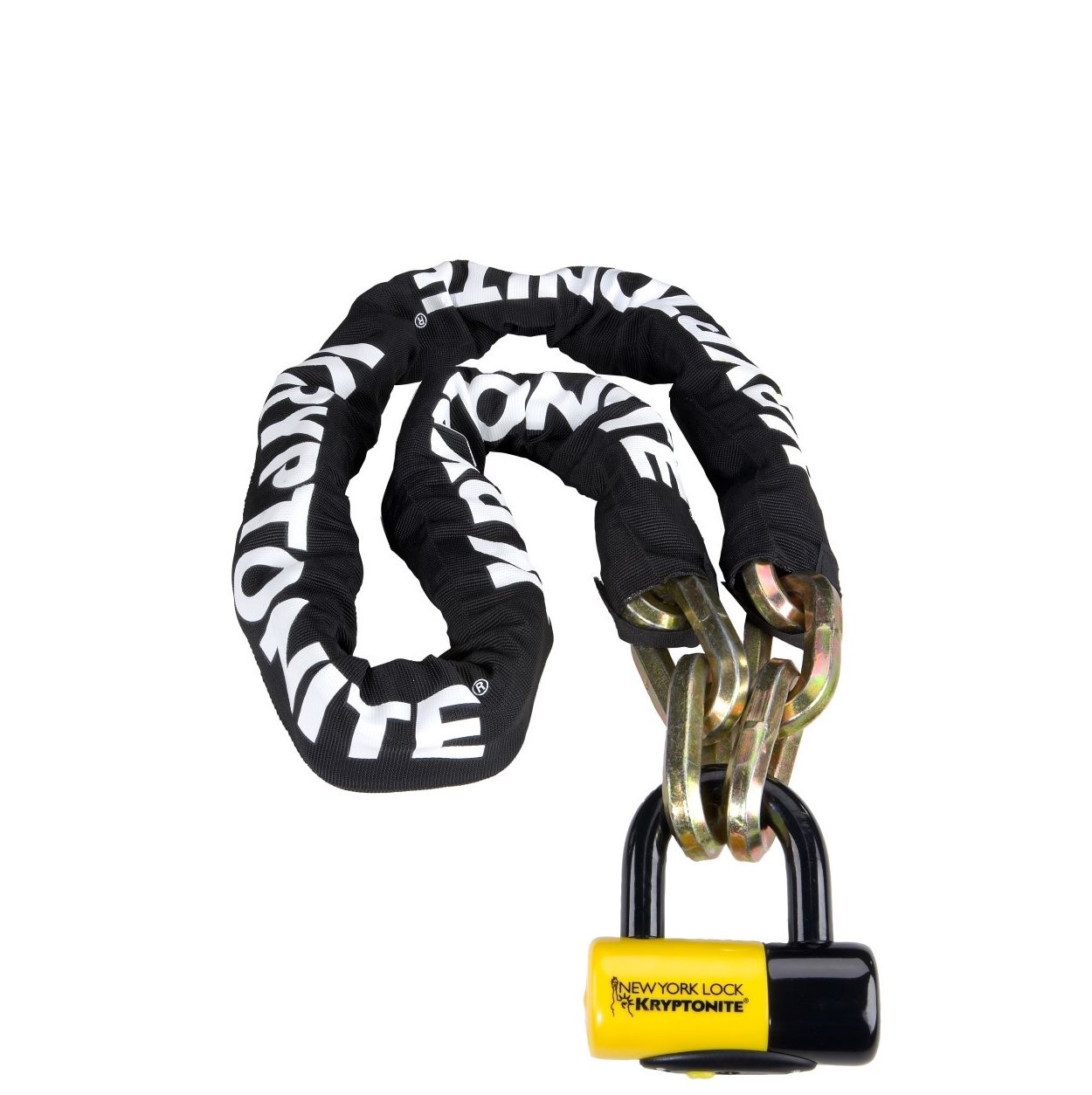
Sold Secure Diamond rated, Kryptonite's chain lock offers more flexibility in locking your bike. However, at nearly 7 kg, it's not the most practical for carrying around.

Abus's top folding lock is easier to carry and lock and has a high Sold Secure Gold rating, which is rare for locks of this style.
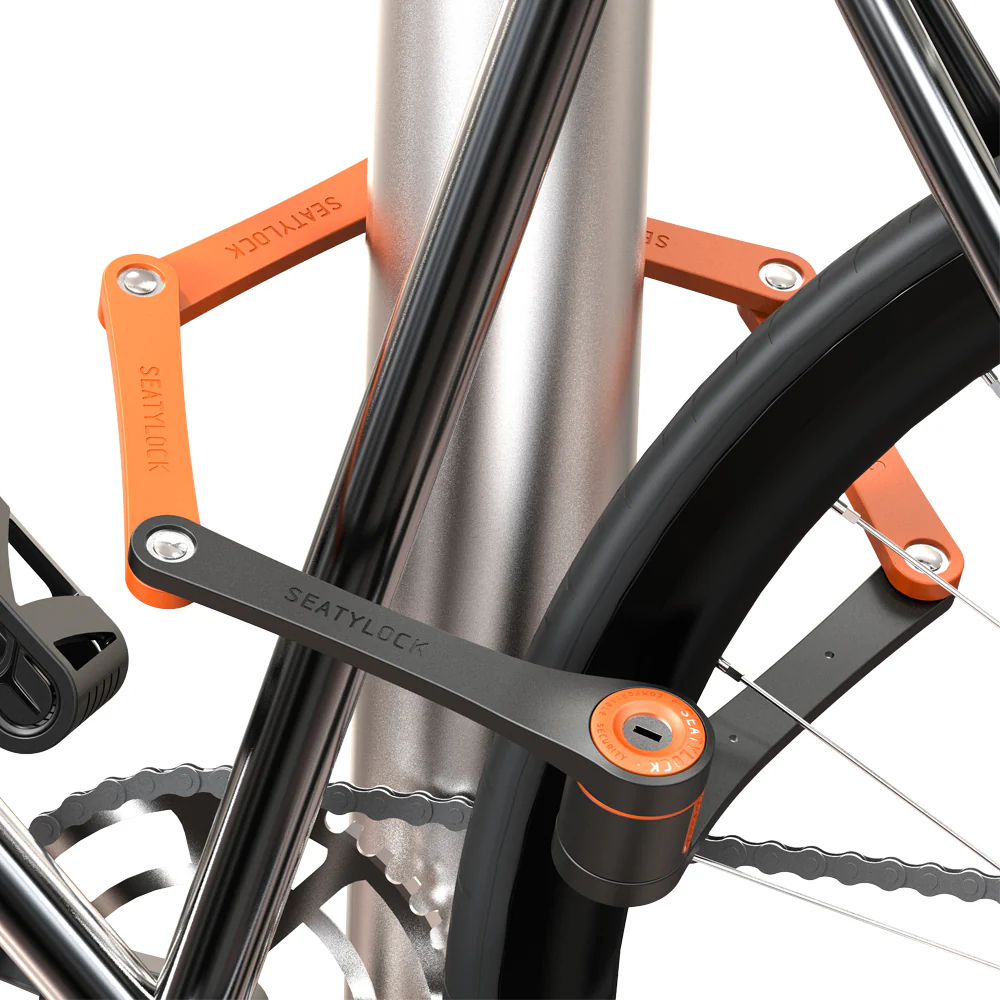
With just enough length to secure the frame and front wheel at a bike rack, the Seatylock Foldylock suffers from the same issue that all folding locks do: a low security rating.
See three more of the best bike locks
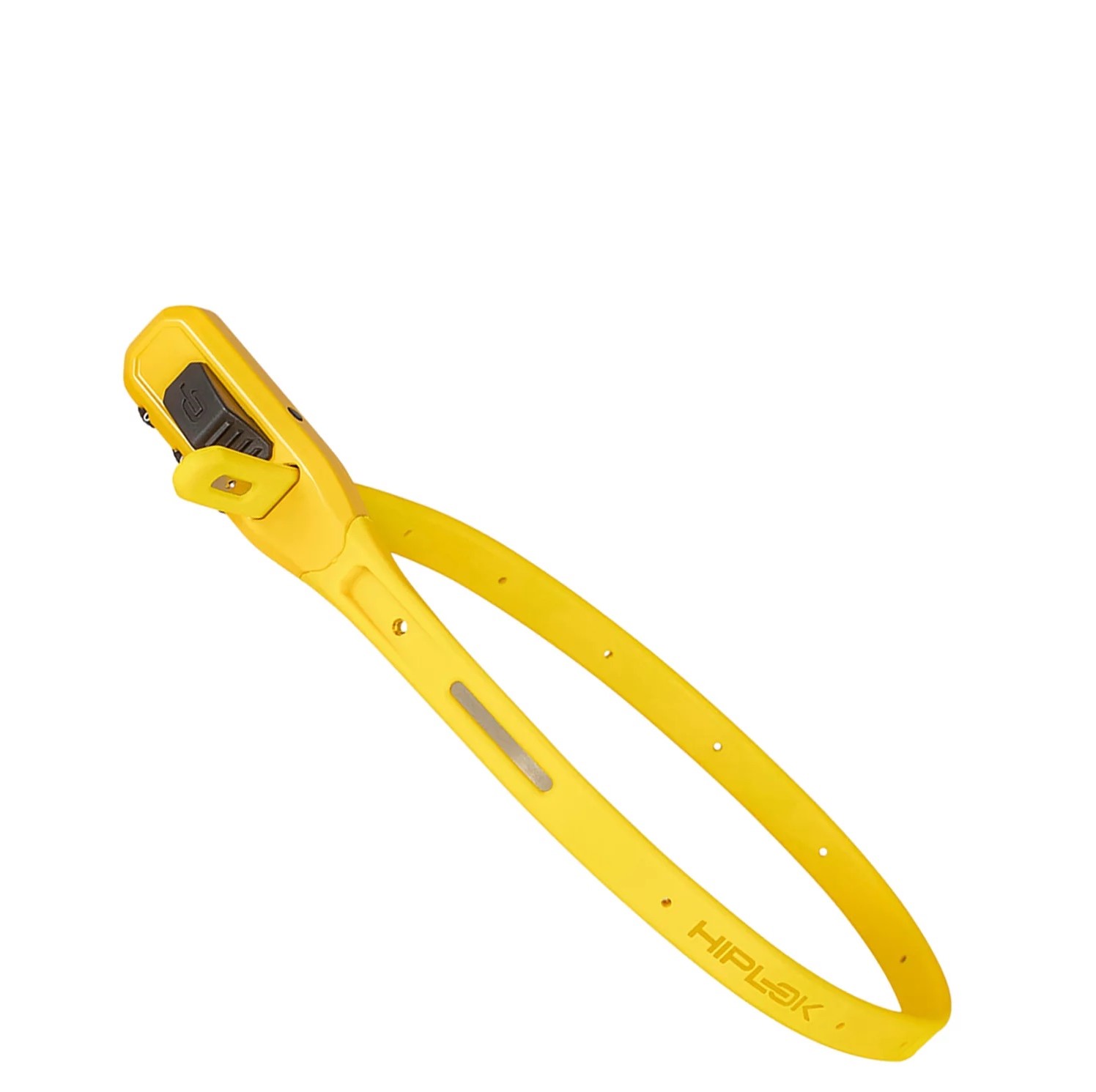
The Hiplok Z Lok is one of the lightest and most portable on the market. Providing enough security for quick stops when you have visibility of your bike.
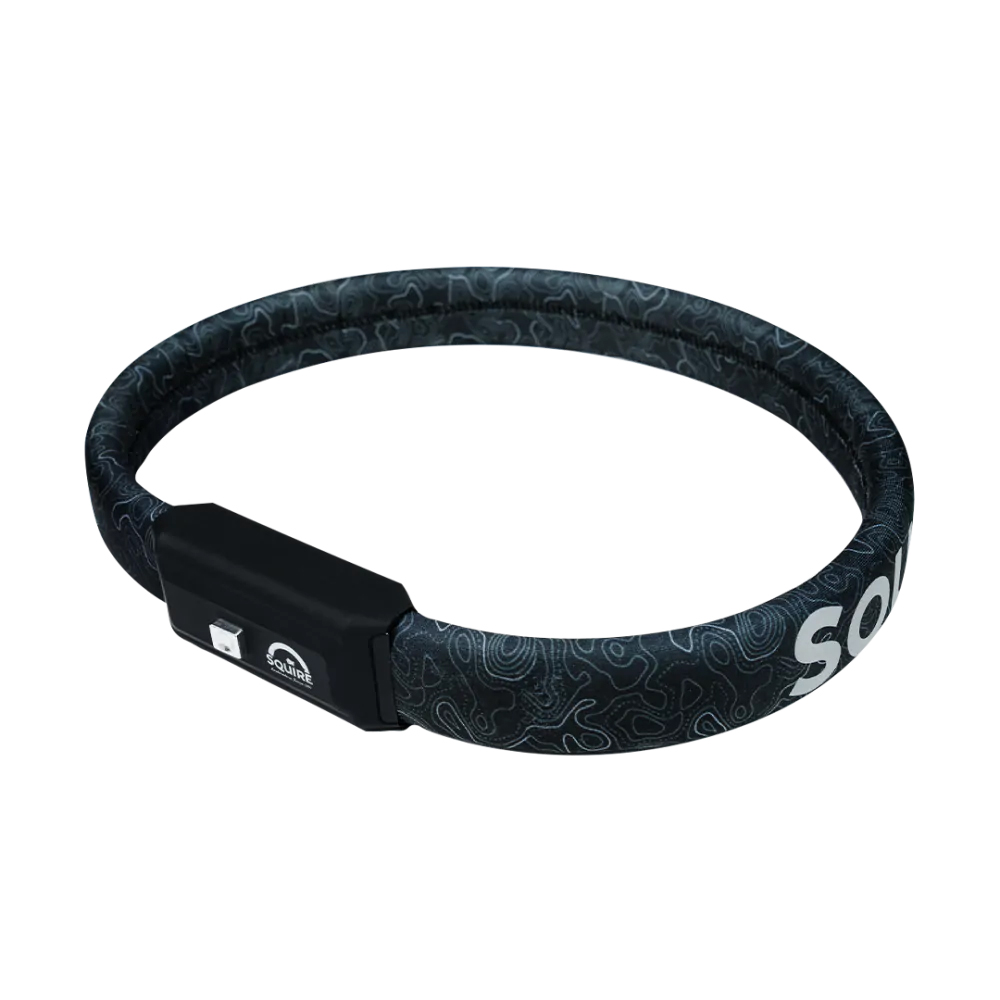
The Squire Straplok 35/850 is incredibly light, and thanks to its belt-like design, I found it super comfortable to wear. It is certainly one of the most well-thought-out locks I have tested.
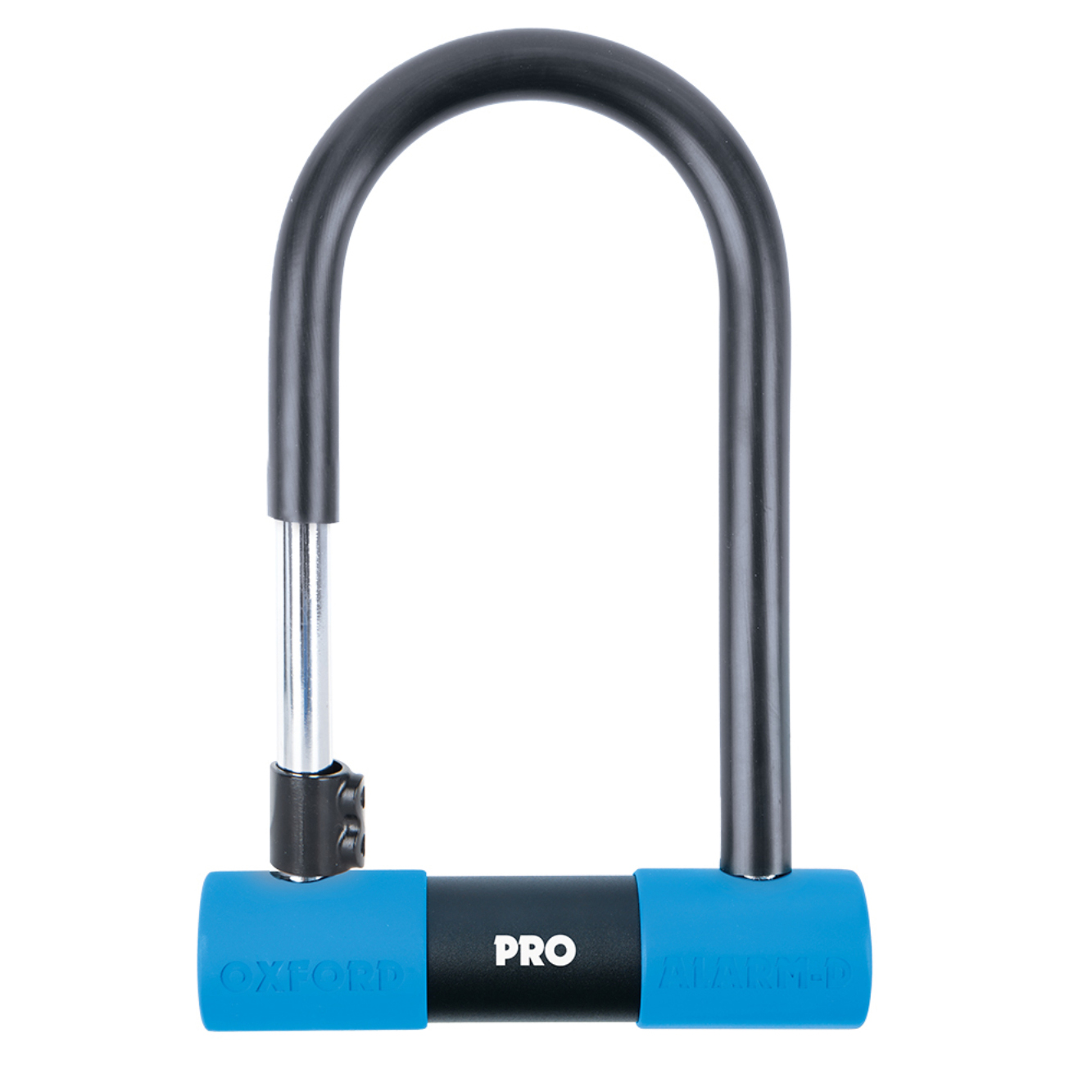
Far from a gimmick, the Oxford alarm is an excellent extra deterrent to thieves, while still performing the fundamentals of a bike lock to a high standard.
Best bike locks: Our pick
Best angle grinder-proof bike locks
Good for: Maximum security. Unless the thief has a lot of time and many grinder discs, you can rest assured that your bike is safe.
Consider: The enhanced security makes losing your key more problematic, as removing them through other means would be quite challenging.
Cycling Weekly has meticulously tested every angle grinder-resistant bike lock mentioned. Whenever a manufacturer asserts a feature, we test its legitimacy using our own angle grinder. We’ve created a brief test that closely simulates a realistic situation where an opportunistic thief attempts to break your bike lock.
Why not check out our full guide to the best angle grinder-resistant bike locks?
Best Overall
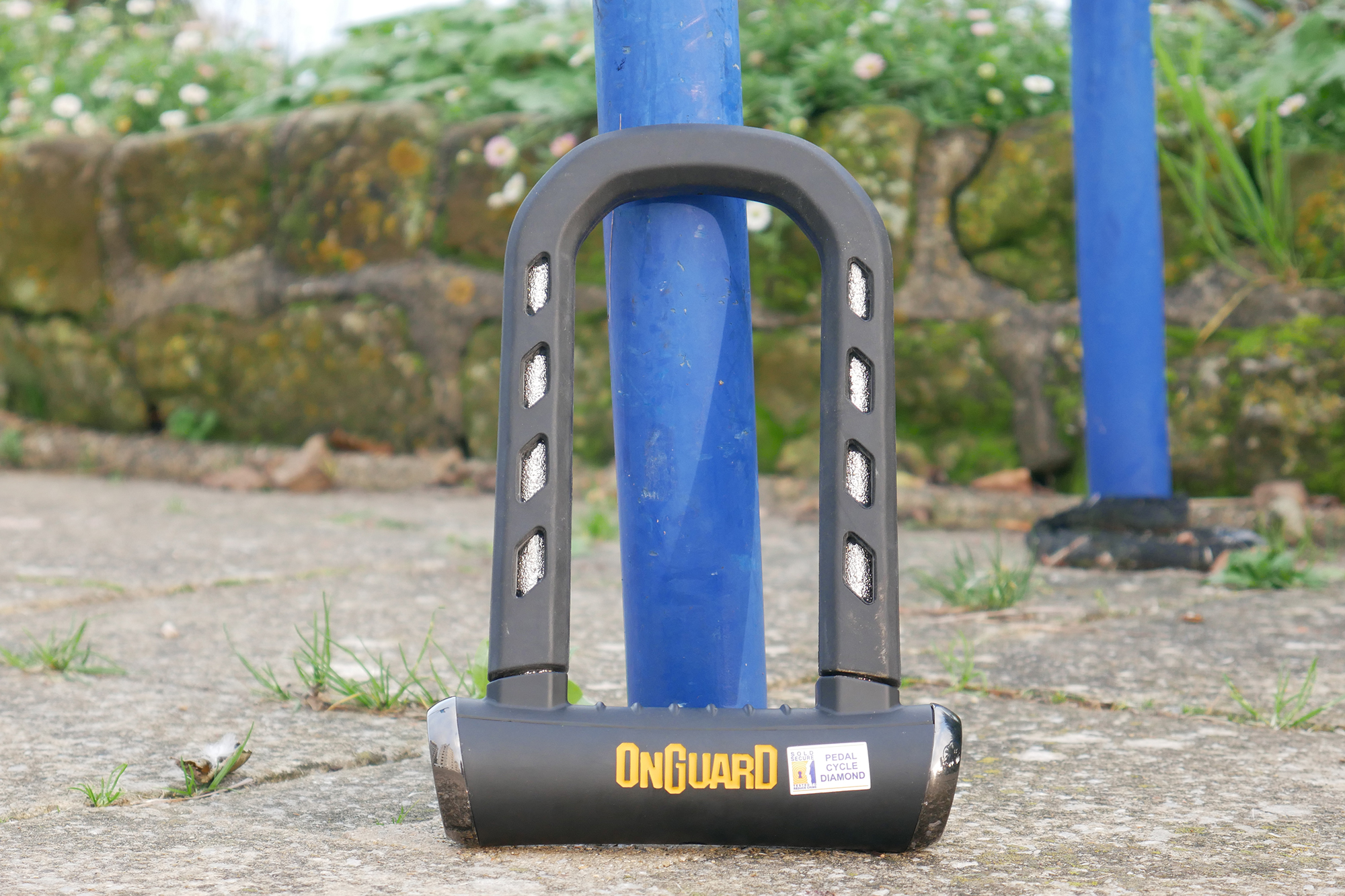
Despite being only 1.3kg/2.8lbs, it is one of the most secure locks available right now
Specifications
Reasons to buy
Reasons to avoid
Unsurprisingly, the OnGuard RockSolid 8590 is our top recommendation and best overall bike lock. It is light, portable, and incredibly robust. As the offspring of security giant Magnum Locks, OnGuard has applied a wealth of expertise and manufacturing know-how to create this small yet mighty Sold Secure Diamond-rated bike lock.
Made of hardened steel and coated with OnGuard’s patented RockSolid finish, the 8590 lock weighs nearly a 1kg/ 2.2 lbs less than its nearest competitor at 1.3kg/2.8 lbs. However, there is a compromise. It has the shortest shackle reach at 17.5cm/6.8 inches, which, with its 9cm/3.5 inches internal width, results in 157cm²/ 61.8in² of locking space volume.
Promising anti-pick, pull, and drill, the key-operated lock mechanism even has a weather shield cover, which should help prevent water ingress and any corresponding loch mechanism degradation or freezing in sub-zero weather conditions.
The OnGuard stands out in the field because of its capability to fend off grinder assaults. On test, we went through no fewer than three grinder discs in five minutes, the most of any lock we've tested. Even then, the grinder barely scratched the surface. This impenetrability is probably why the OnGuard RockSolid 8590 also comes with the most spare keys (five in total) because, trust me, this is not a lock you’ll release easily without a key.
Read our Full OnGuard RockSoild bike lock review
Best budget angle grinder proof lock
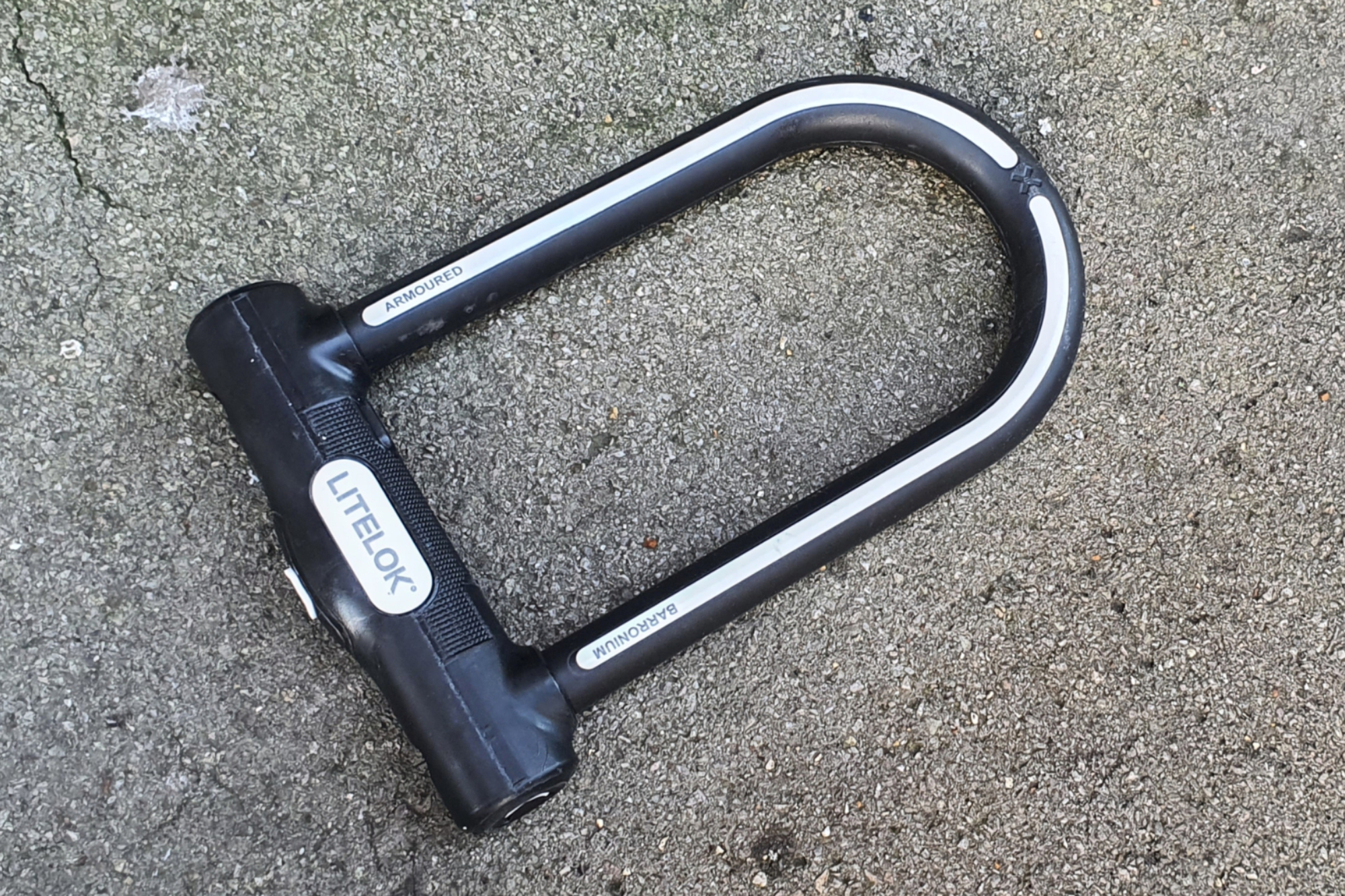
The Litelok X1 offers a diamond security rating and superb angle grinder resistance
Specifications
Reasons to buy
Reasons to avoid
The Litelok X1 has inadvertently become among the cheapest available as a growing number of angle grinder-proof locks enter the market. The lock is diamond-rated, meaning you'll be covered under most insurance schemes. It requires multiple angle grinder discs to penetrate and weighs a reasonable 1.7kg, making it easy to carry around.
As I mentioned, there is a new wave of even more secure angle grinder-proof locks, such as Litelok's X3 and the OnGuard RockSoild. That shouldnt take away from the X1's overall performance, it is still a very secure diamond rated lock that offers pretty formidable angle grinder restistants. Our reviewer really enjoyed using the Litelok X1, especially because of its handy locking circumference. It made locking up the bike in all the various spots they needed a breeze!
For complete peace of mind—when your priority is your bike over the insurance provider’s obligations—the X1 still stands out as a superb choice.
Read our full Litelok X1 bike lock review
Best All-Round Bike Lock
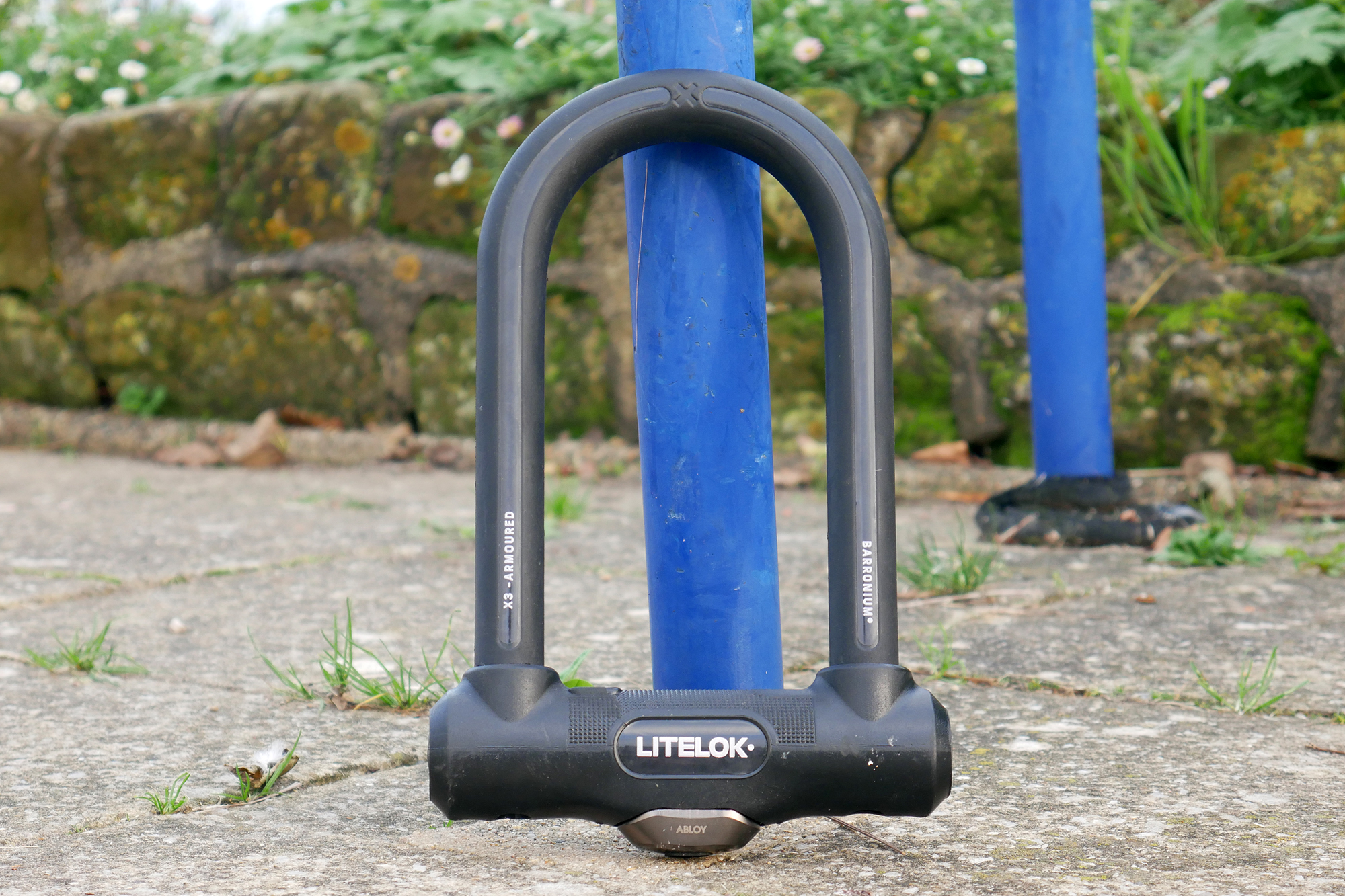
The X3 offers a great balance of security, weight, reach and cost
3. Litelok X3
Our expert review:
Specifications
Reasons to buy
Reasons to avoid
The LiteLok X3 is ideal for anyone looking for the same great Sold Secure Diamond-rated lock security as the OnGuard RockSolid 8590 but with a slightly longer shackle.
The British-designed and manufactured lock uses an exclusive material called Barronium. This super-hard ceramic composite makes the shackle virtually indestructible. During our five-minute angle grinder test, we only managed to cut halfway through the lock, an endeavour that ate through two metal-graded grinder discs.
The LiteLok measures 19.5cm/7.6 inches tall by 10 cm/4 inches wide, the equivalent of 195 cm²/ 76.7in² of total local volume, around 20 per cent more space than the OnGuard.
This extra size adds a little to the LiteLok’s weight when directly compared to the OnGuard, but at just 2.2kg/ 4.8lbs, it's the equivalent difference of an extra water bottle, so it's hardly excessive.
I really liked the LiteLok X3’s silicon outer, which helped prevent my frame from being scratched. The nifty neoprene pouch was also a great storage addition for the lock. However, I wasn’t so keen to find that the bespoke bike frame lock mount would be an additional £20 outlay, especially after discovering that it wouldn’t fit most small frames, which is another point to consider when deciding to purchase.
Best U-Locks
Good for: High levels of security and easy to transport in a bag or pannier. The most simple to use, U-locks are also the best way to protect your paintwork.
Consider: U-Locks tend to have a shorter reach, so consider where you are locking your bike and if this style would be suitable.
U-locks are considered the most secure way to lock your bike. Their solid looped design offers very few weak points, and the simple manufacturing process allows for the use of extremely durable materials. Most offer decent protection for your frame from the elements with soft plastic or silicone coverings. Mounting U-locks on your bike can take up frame space, so I recommend slipping them into one of the best cycling backpacks or best pannier bags.
Best Budget U-lock
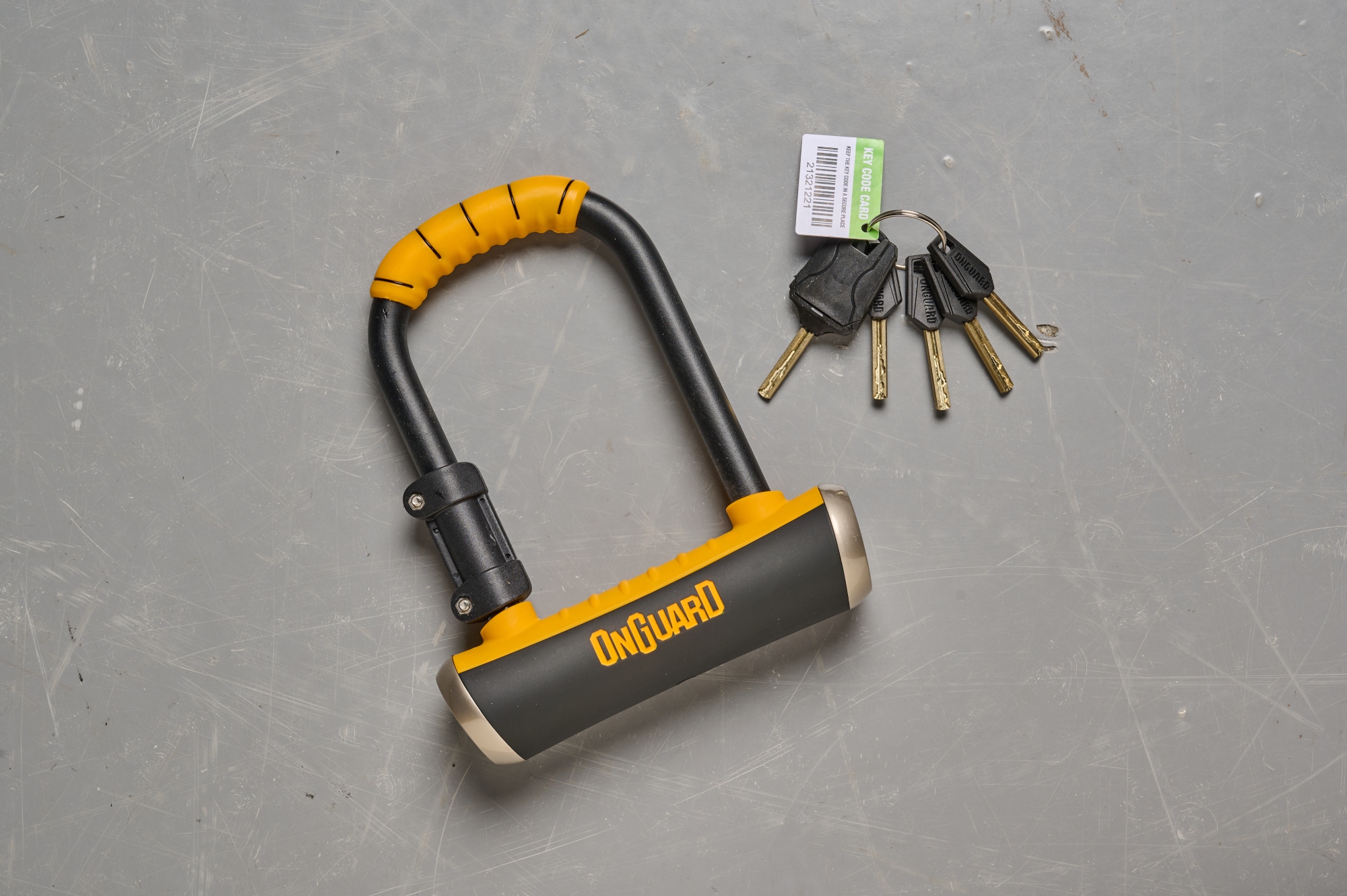
4. OnGuard 8006 Pitbull Mini
Our expert review:
Specifications
Reasons to buy
Reasons to avoid
Gram-for-gram, the Pitbull mini packs quite a punch. Despite only weighing 1.3kg it delivers a Diamond Sold Secure rating. It achieves this by measuring just 9cm x 14cm while still featuring a 14mm hardened steel shackle and a pick, pull and drill-resistant ‘bump lock’ cylinder. Its weight and dimensions makes it easily portable, either using the supplied mounting bracket or stuffed into a bag;
I found it rattled less than a larger U-lock when mounted to the frame although it didn’t feel quite as solid as either of the folding locks. Naturally it’s size means the internal locking space is small, and will limit how and what you can lock your bike too - so perhaps not ideal for those who require some flexibility.
However if you're locking your bike up to the same point each time, and know this compact lock fits, then it’s a great way of reducing your carrying weight without having to sacrifice the security rating.
Best U-lock for reach
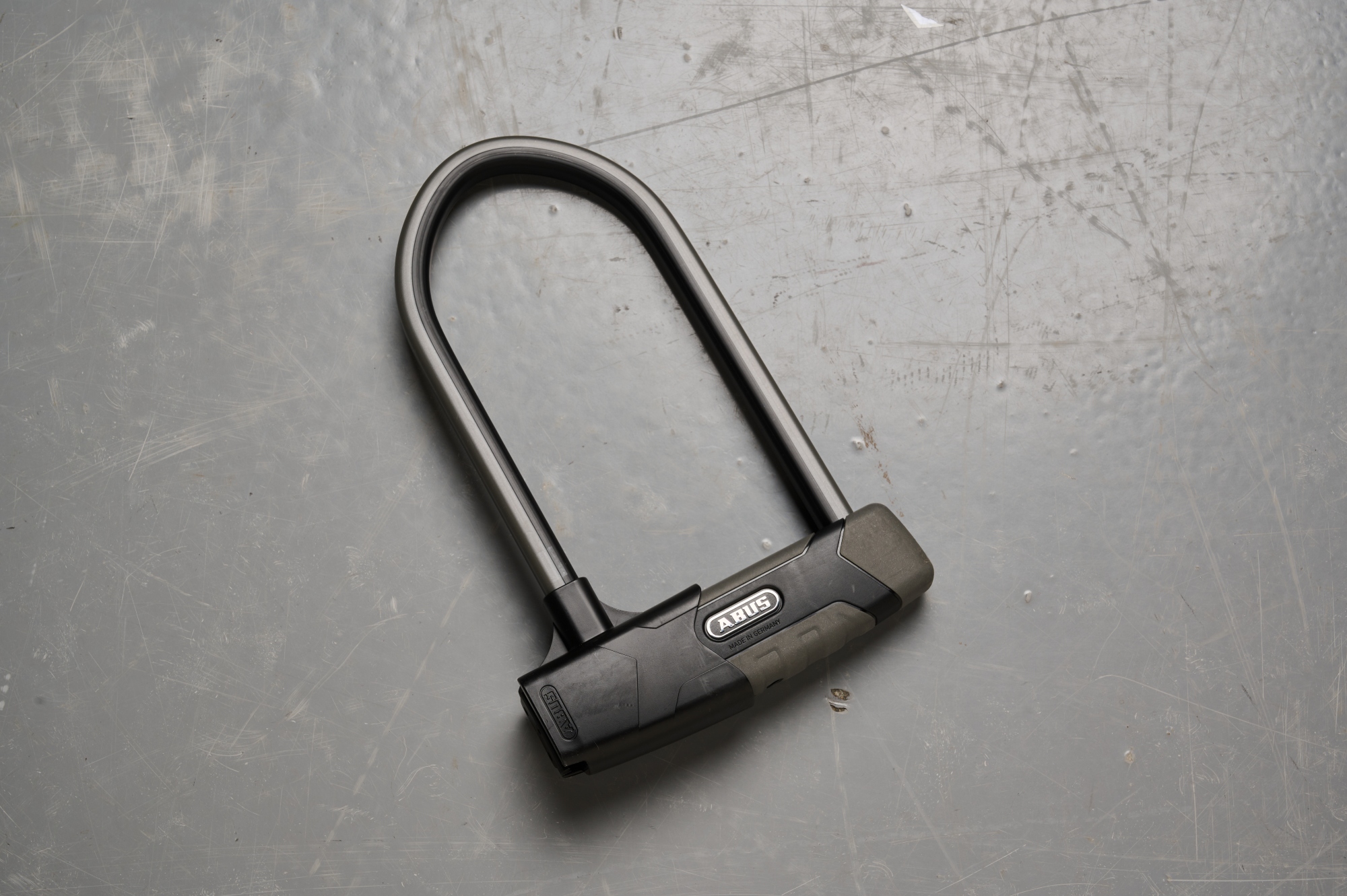
5. Abus Granit X Plus 540
Our expert review:
Specifications
Reasons to buy
Reasons to avoid
The Granit Xplus 540’s 23cm shackle height and 10.8cm inner width means you have plenty of room to manoeuvre. While it doesn’t offer quite as much flexibility as the brand’s Bordo folding lock, it still allows for a variety of locking possibilities.
Its Diamond rating is secured through a combination of 13mm temper hardened steel square parabolic shackle and a double bolting shackle and lock body, with the latter designed to deliver protection against picking. The lock also has the feel of something that’s well-made and features an automatic keyhole cover; having had a couple of locks jam on me in the past, this is a worthwhile detail.
It comes with a flexible mounting point that allows it to be attached to the top, down and seat tube - depending on your frame of course. It’s certainly light enough to carry in this manner, although like all ‘full-size’ U-locks it’s likely better stored in a backpack. Its security rating also makes it another consideration for home use.
Best cheap bike lock
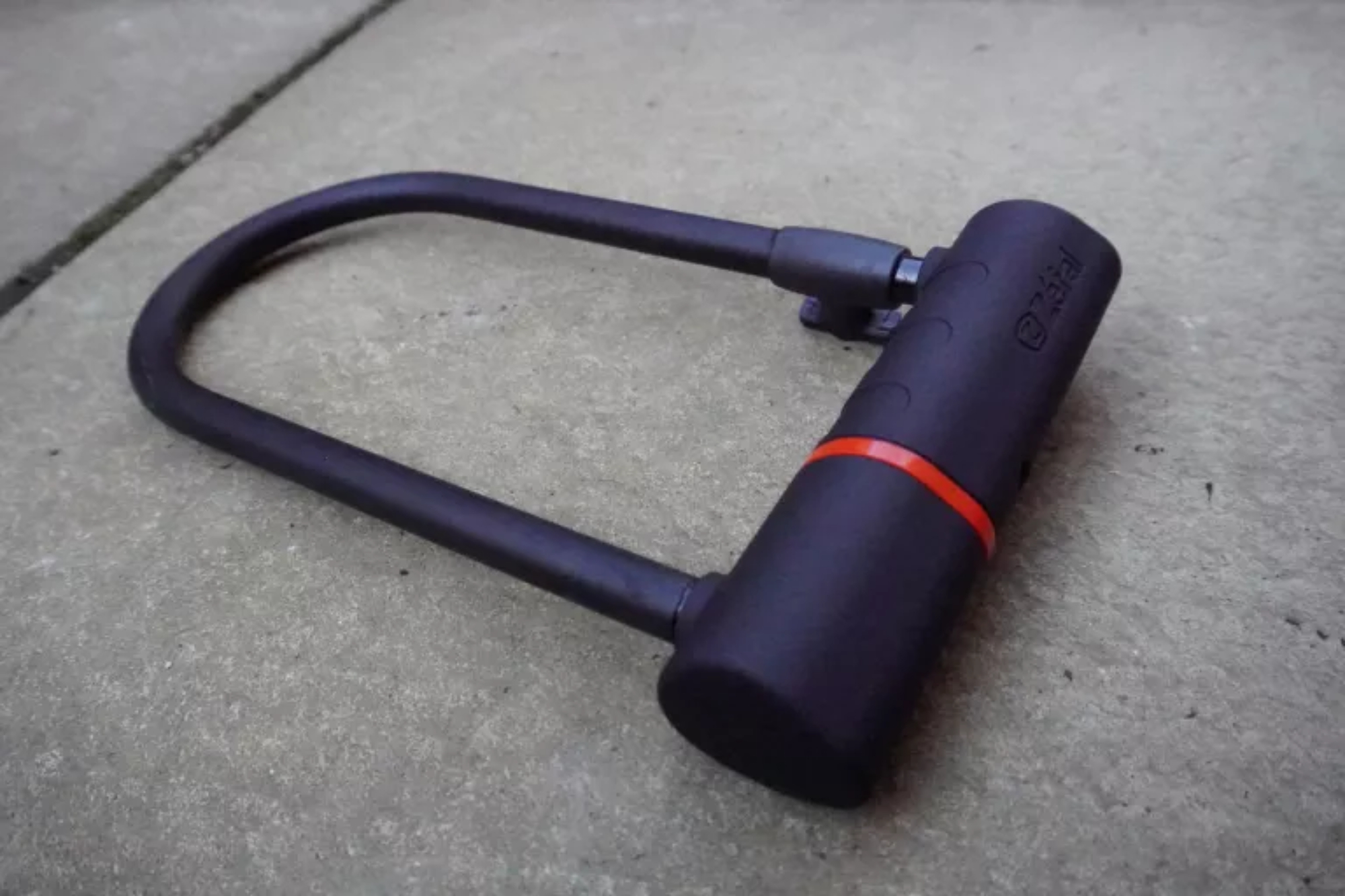
The K-Traz U17 offers value for money without compromising security
Specifications
Reasons to buy
Reasons to avoid
A brilliant low-cost option, making Gold Sold Secure even more accessible to everyone. At this price, it wouldn’t even be too much of an outlay to buy one for every bike in your household. Although it might be tempting to use one lock to secure multiple bikes, especially if you have a longer chain link lock, that only serves to tempt thieves. Far safer to have locks for each one.
At just under 1.3kg, the K-Traz U17 is surprisingly lightweight—especially considering its price and security rating. A complete plastic coating minimizes the risk of paintwork coming into contact with metal.
The two downsides are the straight shackle, which makes it more difficult to mount the crossbar than a bent design and the plasticky bike mount. We found this a little fiddly to set up, as it uses two long screws to clamp the bracket to the frame, and the release mechanism for extracting the lock feels a little flimsy which makes it a bit of a struggle to dismount the lock.
For the money, we think the K-Traz U17 is a brilliant lock, but if you’re after quality all-round performance, you will need to set your price bracket a little higher.
Read our full Zéfal K-Traz U17 lock review
Best Chain Locks
Good for: Chain locks can offer high levels of security, with many offering good reach and excellent flexibility.
Consider: Not all chain locks are strong, so check the Sold Secure rating. Chains are almost always the heaviest options and as a result, can be difficult to carry around.
Assuming a high Sold Secure rating, chain locks are one of the safest ways to secure your bike, links mean multiple tools or cuts are required to break them apart. The obvious advantage is the additional reach and unlimited flexibility, great for places where purpose-built bike storage is not available. Don't be surprised by the weight though, that metal all adds up, expect to carry at least five kilos for a short one.
Best chain lock Overall
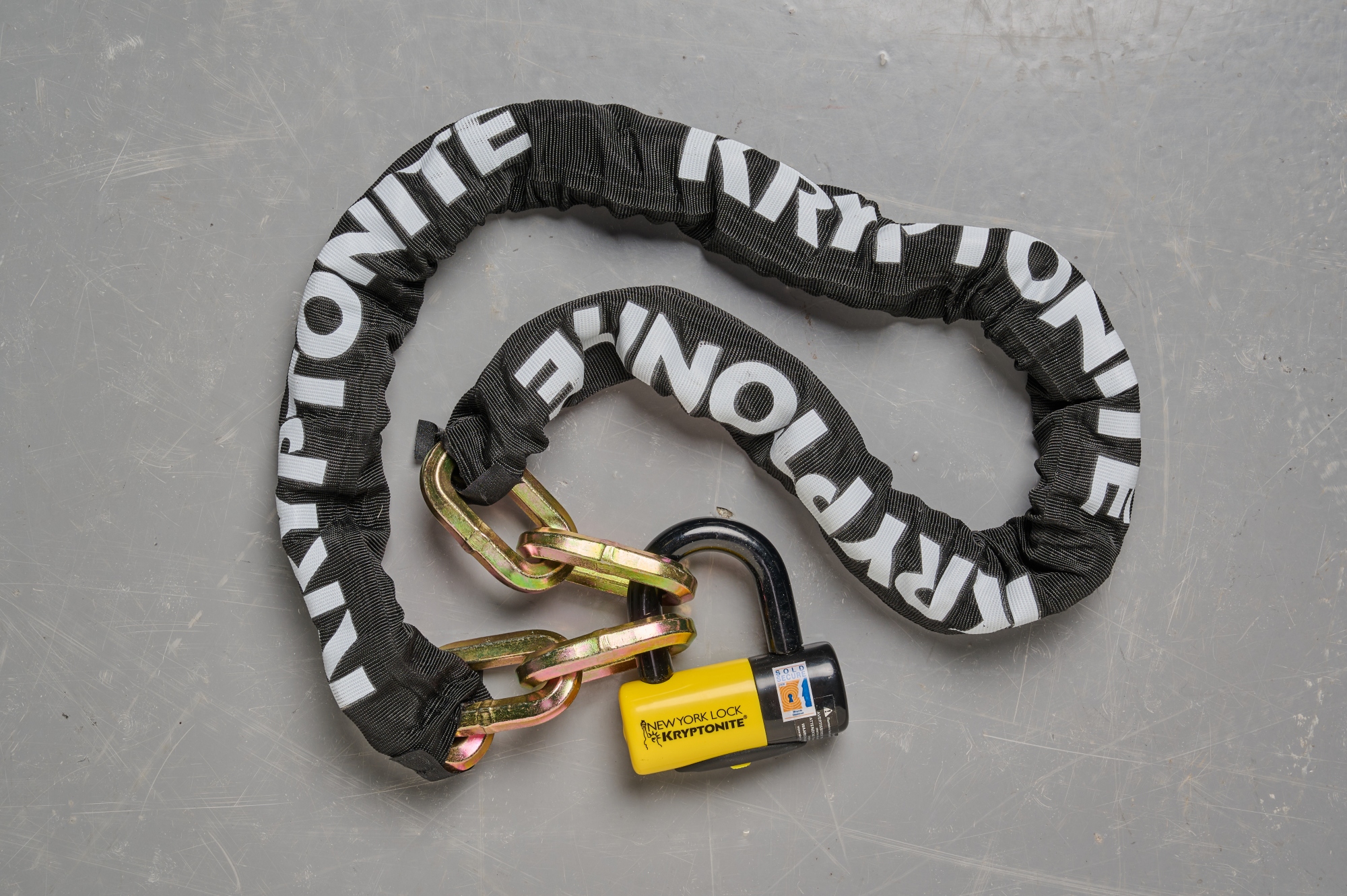
Kryptonite's chain design offers plenty of flexibility when it comes to locking up your bike
7. Kryptonite New York Fahgettaboudit Chain 1415
Our expert review:
Specifications
Reasons to buy
Reasons to avoid
Visual, the Kryptonite New York Fahgettaboudit chain lock is a serious deterrent to any thief. At 150cm long, made from a series of 14mm six-sided, 3t hardened manganese steel links and weighing just under 7kgs, it's a real brute of a lock. The proved padlock features a 15mm steel shackle, constructed around a disc-style cylinder which should offer effective protection against drilling.
Unsurprisingly its heft makes the chain far too heavy to carry around, as someone who doesn't use panniers; after trying both around my waist and chest the Fahgettaboudit was destined for home use only. Its Diamond rating and length were supreme for locking multiple bikes in the shed, reaching around both with enough room to lock it to an anchor.
Read the full Kryptonite New York Fahgettaboudit Chain 1415
Best folding locks
Good for: Folding locks are super compact, combining the flexibility of a chain lock without the weight or complication of carrying it.
Consider: Due to how folding locks are manufactured, the joints offer an obvious weakness and don't tend to get the highest Sold Secure ratings.
Folding locks offer a fantastic alternative to chain locks especially if you ride without a bag or pannier. Almost all can be mounted to a bottle cage or with straps to your frame tubes, which means they can always be on your bike with little penalty. Their compact nature makes them brilliant for Bikepacking, locking multiple bikes together or lassoing your bike to a tree. Be careful as this design is inherently flawed with each link offering a weakness to be exploited, only a few folding locks have been awarded a gold Sold Secure rating.
Best folding lock overall
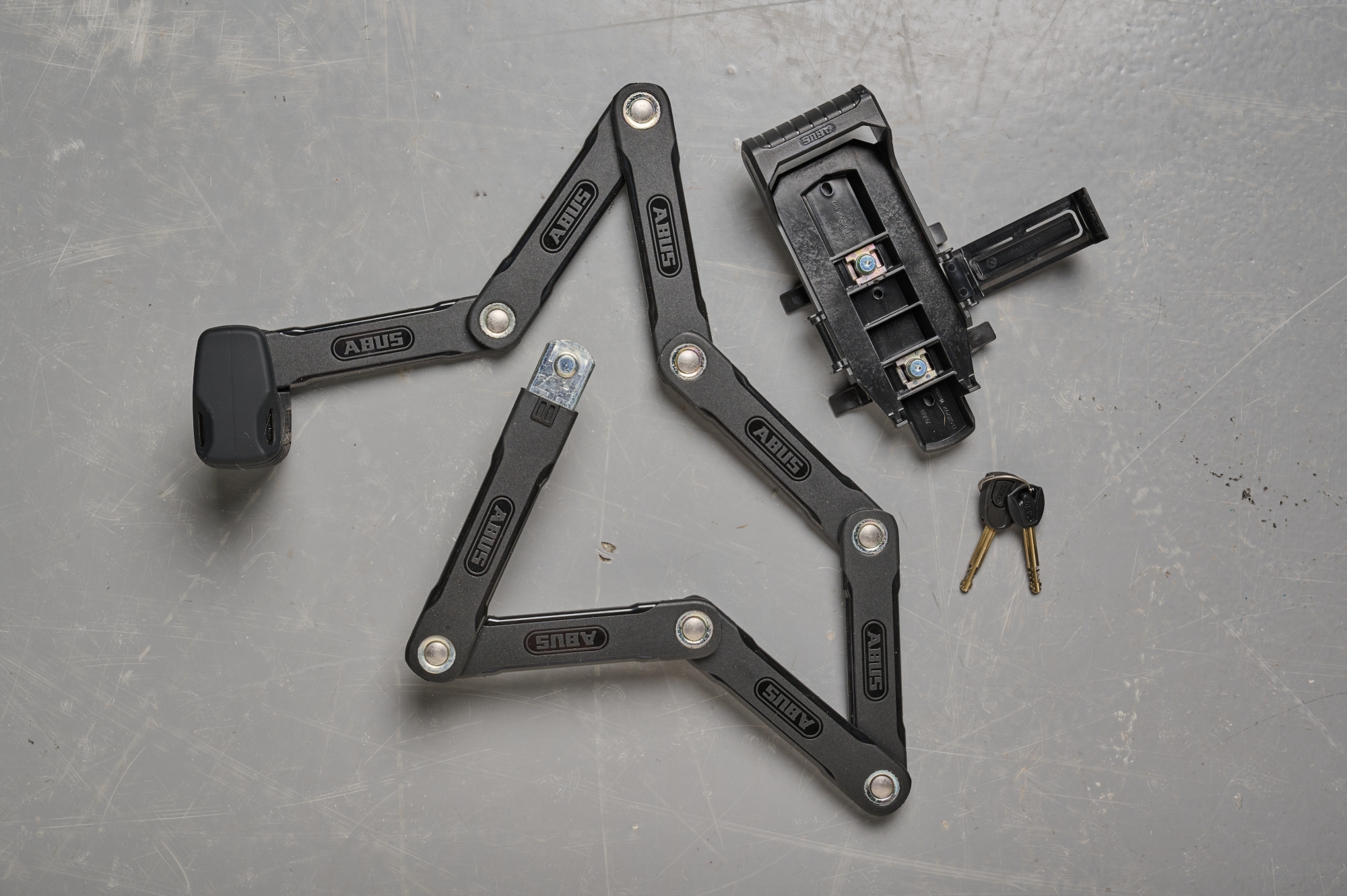
The Bordo 6500 Granit X-Plus lock offers a large lockable area that can secure two bikes if needed
Specifications
Reasons to buy
Reasons to avoid
Folding locks offer several benefits over the venerable U-lock design. They tend to pack down smaller and have a larger lockable area, and their flexible nature greatly increases the range of objects you can lock your bike to.
The typical downside of a folding lock is that it has so many moving parts. They tend to be less secure than a simpler design, such as a U-lock. The hinge areas add a potential point of attack that's not there with U-lock.
As such, the Abus is one of the only Gold-rated folding locks currently available. However, this superlative security comes with a couple of trade-offs. At just under two kilos, the Abus lock is over four times as expensive and weighs just over half as much again as the Gold-rated Zéfal K-Traz U17.
The Bordo Granit X Plus certainly isn’t all things to everyone—but it isn’t trying to be. As a high-security folding lock, it performs excellently. In addition to all the general benefits of folding locks, the Abus has a comprehensive rubber coating to protect your paintwork, a bike mount that is simple to set up and to use day-to-day, as well as an integrated weather seal on the lock barrel—adding some very welcome weather protection.
On review, we found the bike mount not only straightforward to use but also capable of keeping the lock firmly in place, even when we were cycling on uneven and bumpy roads. Once we'd arrived at our destination, the Bordo Granit X Plus' large lockable area made it easy to lock up our bike without any fuss; in fact, we even locked up two town bikes using the one lock.
Read our full Abus Bordo Granit X Plus 6500 bike lock review
Best Budget Folding Lock
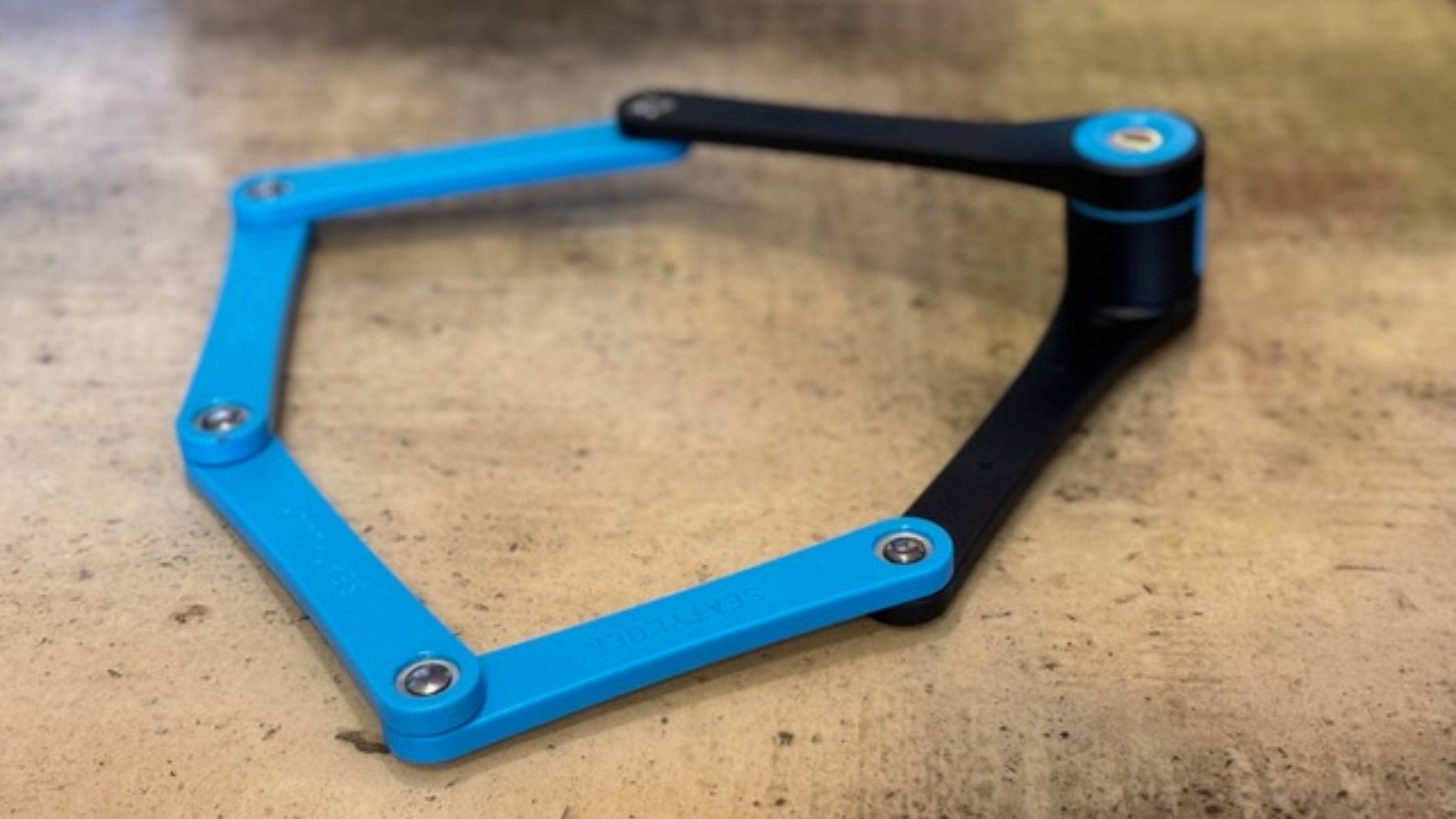
Seatylock Foldylock compact is a fantastic compact folding lock that really takes the fight to Lock giants Abus
Specifications
Reasons to buy
Reasons to avoid
As the name states, it’s a small folding lock. It comprises six steel bars, joined by stainless rivets, that add up to a circumference of 85cm; I found this internal locking space offers just enough room to secure the lock through the front wheel and frame before attaching it to a bike rack or similar. Due to its smaller size, it was less cumbersome and thus easier to use than the folding Abus - it’s as quick to lock up as U-lock but with a little added flexibility that’s inherent in the design.
When folded away it measures just 18.9 x 6cm, which likely makes it one of the smallest and lightest Silver-rated locks around. Again, like the larger Abus lock, it can be secured to your bike’s bottle cage mounts using a plastic case; similarly, it feels secure and silent when in transit. If a combination of weight and portability is important to you then the Compact should have plenty of appeal.
Read our full Seatylock Foldylock Compact lock review
Best Lightweight & Wearable Locks
Good for: Leaving your bike for short periods, stopping opportunistic thefts and being easily transported. The best lightweight bike locks are great for bikepacking, cafe stops and popping into the post office.
Consider: Using much higher-rated locks if you plan to leave your bike for long periods or out of sight.
While lightweight and wearable locks function slightly differently, they ultimately solve the same problem. Transportation of locks can be frustratingly difficult, especially if they are heavy or offer little flexibility. The trade-off is less security, which for most will be for very short periods or when the bike is in sight.
Why not check out our full guide to the best lightweight bike locks?
Best Lightweight Lock Overall
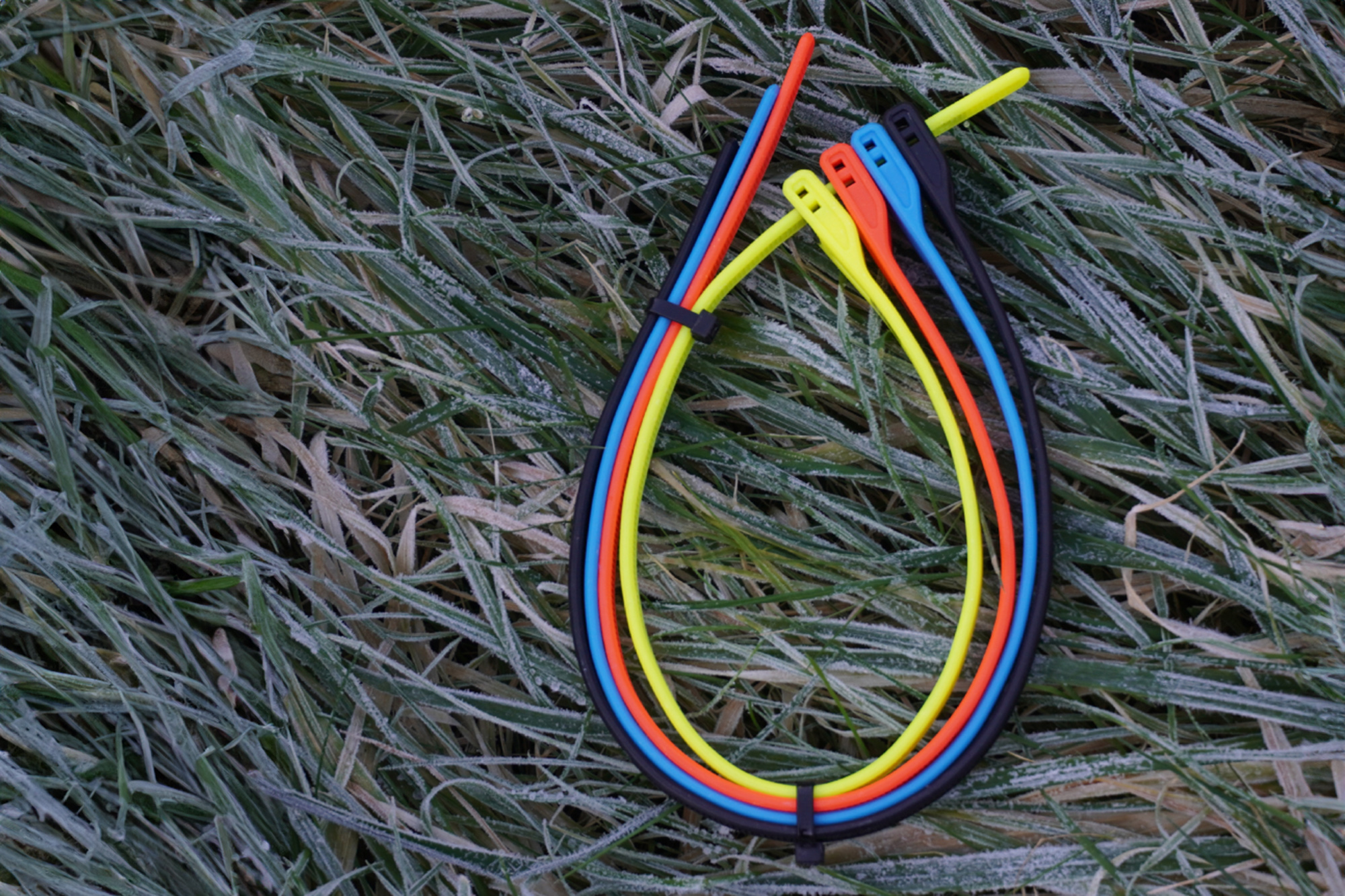
The Z Lok is our best lightweight and portable lock and is well-suited to coffee stops
Specifications
Reasons to buy
Reasons to avoid
The Z Lok weighs only 70g, so you won’t feel burdened if you stuff it into your pocket or clip it around your frame. Its design resembles an oversized zip tie, and inside the plastic covering is a steel ribbon.
We reckon that if you use the Z Lok to secure your frame to a post or railing, it’s enough to stop a thief from walking away with your bike, although it’s unlikely to stand up long to a bolt cutter and its security level is unrated. Its steel band design is significantly more robust than other lightweight locking options, which tend to use thin cables, though.
At 40cm long, our reviewer found that it’s long enough to secure your frame to something immovable and possibly your rear wheel. Because of its zip tie-like design, you can also shorten the loop to make it harder to get leverage with a cutter. When unlocked, there’s a release lever to undo the ratchet.
In summary, we found that it’s a clever, useful piece of kit to carry around for coffee stops or quick bike errands. It's also cheaper than a full-strength lock.
Read our full Hiplok Z Lok Combo bike lock review
Best wearable lock overall
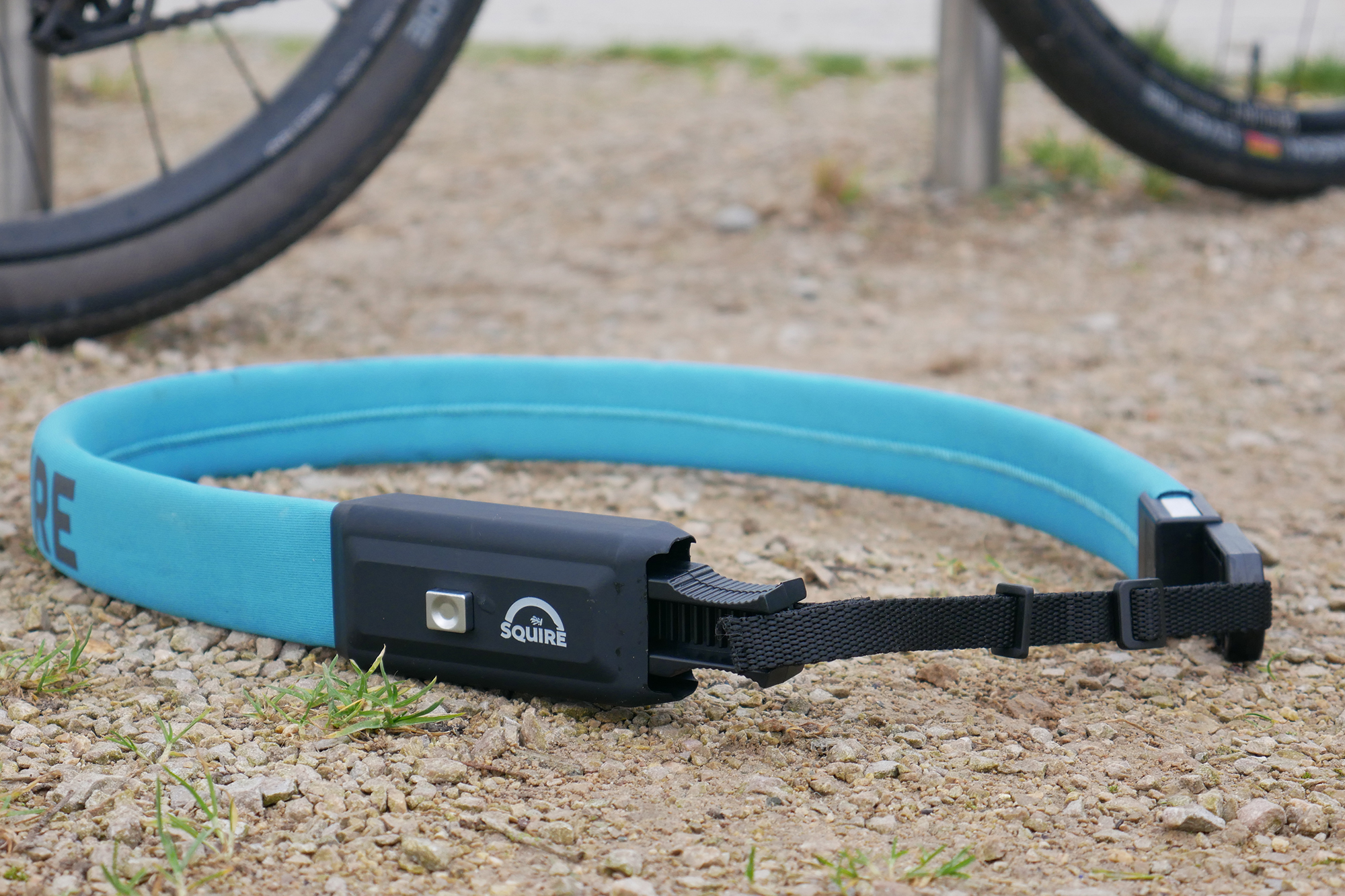
A brilliant wearable adapter means the Straplok stays secure and comfortable
Specifications
Reasons to buy
Reasons to avoid
The Straplok 35/850 is made in the UK and features high-tensile steel cores with a neoprene cover. Squire secures it using a patented ‘linear pin tumbler’ lock. To unlock, insert the key without turning it and push the button.
The Squire Straplok has plenty of appealing features, beginning with its comfort. Squire invested significant effort in creating the belt adapter, which was designed to maintain tension and secure the lock while pedalling. Additionally, the neoprene cover enhances this comfort, providing a soft touch to the lock.
Thanks to its amazing flexibility, using the Straplok at the bike rack is effortless. The straightforward button lock barrel simplifies unlocking and locking, particularly in awkward or confined spaces.
Nonetheless, there are drawbacks. Although the Straplok has earned a 4.5 out of 5 stars, it is only rated with a Sold Secure silver certification. This rating may limit its uses and affect the overall worth of the bike you choose to secure with it.
Read our full Squire Straplok 35/850 bike lock review
Best Alarmed Locks
Good for: Leaving your bike for long periods of time out of sight, the alarm will alert just about anyone if something suspicious is happening.
Consider: The trade-off for this additional deterrent is that, as far as I am aware, no diamond-rated alarm-equipped locks, meaning you will sacrifice overall security.
Alarm-equipped locks can be useful if you need to lock your bike a long way from your intended destination or plan to leave it for a long period like at a train station. The alarm will raise awareness in the immediate vicinity in the hope someone will contact the police.
Best Alarmed U-Lock Overall
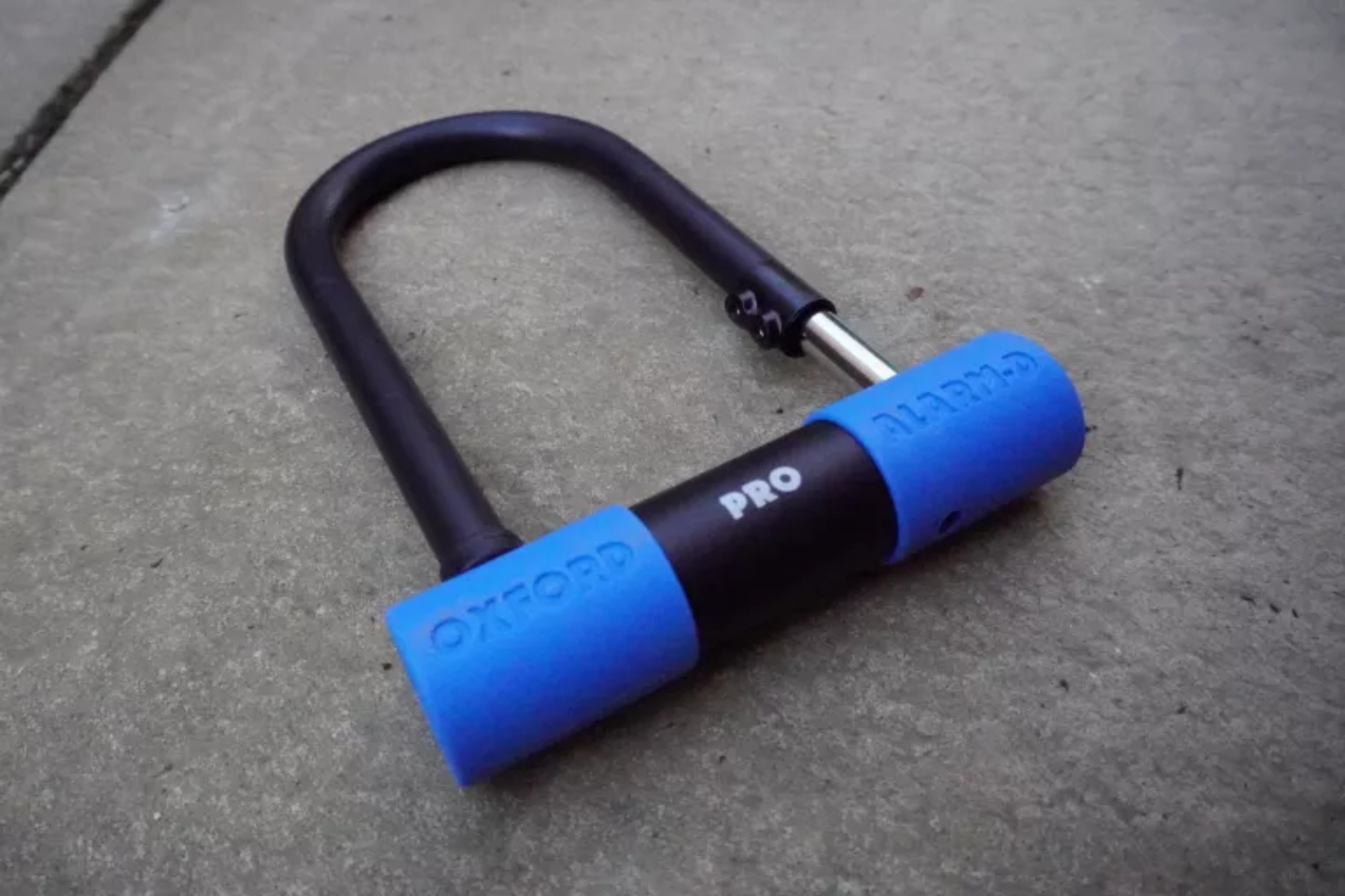
As the name suggests this Oxford lock features an in-built alarm
Specifications
Reasons to buy
Reasons to avoid
As the name would suggest, this Oxford lock comes with an inbuilt alarm that will sound if the internal motion sensors detect any tampering. It’s very simple to use, with arming and disarming controlled by just a turn of the key in the lock.
The calibration of the motion sensor was pretty spot on, detecting any suspicious fumbling, but not going off when the bike was just knocked a little when locking another up next to it. With the battery easy to access (when the lock is open), you can quite easily disable the alarm completely if you need it to work simply as a lock for any reason.
But this lock is by no means a novelty, it performs the basics really well. The bent shackle makes it easy to attach the crossbar, three keys are provided with more orderable, the bike mount is easy to set and works well in day-to-day use, plus its weight is pretty middle of the road for this style of lock.
The only reservation I have about this lock is that the rubber bumpers on the crossbar don’t extend all the way across, so some care is needed not to scratch your bike on the middle section of exposed metal.
Read our full Oxford Alarm-D Pro lock review
Specification Comparison
Security Rating | Weight | Type | |
OnGuard RockSoild 8590 | Sold Secure Diamond | 1.3kg/2.8lbs | U-lock |
Litelok X1 | Sold Secure Diamond | 1.7kg/3.7lbs | U-lock |
Onguard 8006 Pitbull Mini | Sold Secure Diamond | 1.3kg/2.8lbs | U-lock |
Abus Bordo Granit X Plus 6500 | Sold Secure Gold | 2.4kg/2.5lbs | Folding Lock |
Litelok X3 | Sold Secure Diamond | 2.2kg/4.8lbs | U-lock |
Abus Granit XPlus 540 | Sold Secure Diamond | 1.6kg/3.5lbs | U-lock |
Zéfal K-Traz U17 | Sold Secure Gold | 1.2kg/2.6lbs | U-lock |
Kryptonite New York Fahgettaboudit Chain 1415 | Sold Secure Diamond | 6.9kg/15.2lbs | Chain Lock |
Seatylock Foldylock Compact | Sold Secure Silver | 1kg/2.2lbs | Folding Lock |
Oxford Alarm-D Pro | Sold Secure Gold | 1.4kg/3lbs | Alarmed U-lock |
Hiplok Z Lok Combo bike lock | Not Classified | 70g/2.4oz | Strap Lock |
Squire Straplok 35/850 | Sold Secure Silver | 1.1kg/2.4lbs | Wearable Lock |
How we test bike locks
The Cycling Weekly testing team tested locks against the varied rigours of urban and utility cycling, using them on rides to the Bath & London offices, the supermarket, pubs, and to run errands around town.
Our testing is primarily focused on the everyday use of a specific lock. Ultimately, our rating will depend on key metrics such as weight, shape, locking mechanism, mounting attachment, tactile feel, security rating, and value – essentially every lock quality in real-world scenarios.
The Cycling Weekly tech team seldom subjects a lock to destruction testing unless it asserts that it is angle grinder resistant, and there's a valid reason behind this. There are reputable, independent, and officially recognized testing organizations like Sold Secure. Moreover, as I have pointed out throughout this guide, no bike lock can be considered completely unbreakable.
A great way to safeguard your bike is to get an insurance policy that specifies the required security rating for your bike lock.
For more details on how Cycling Weekly tests products, check out our How We Test page
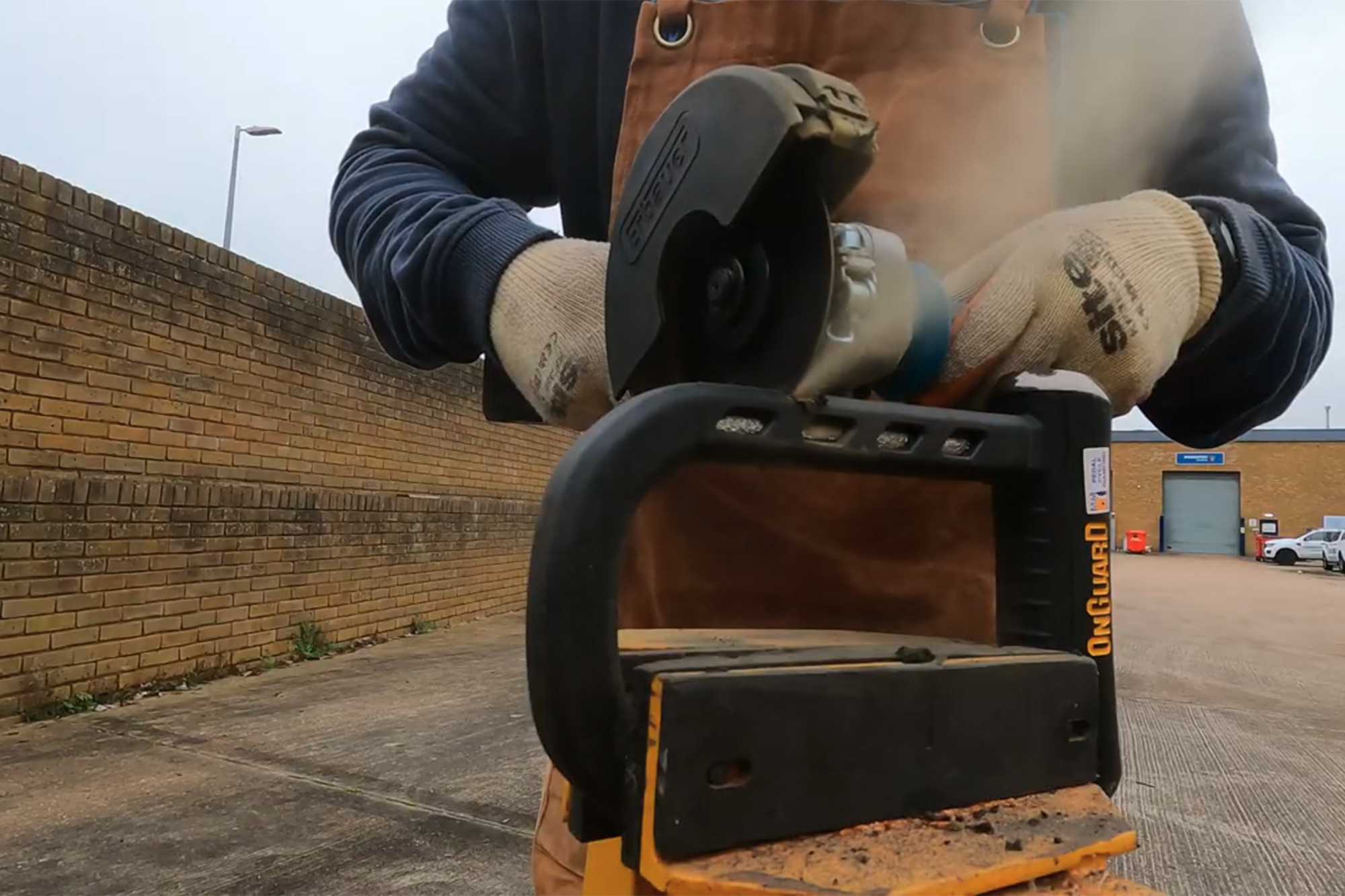
How do we test angle grinder-proof bike locks?
To cut a bike lock using an angle grinder, you must either make two precise cuts—one on the shackle and one on the lock barrel—or perform one cut on the shackle and then twist the lock off. However, since most modern locks come equipped with anti-twist and tamper-resistant features, I would likely need to execute two clean cuts instead.
I equipped myself with a powerful battery-powered angle grinder, using high-quality metal cutting discs, and set a maximum time limit of five minutes. This time frame allows for any necessary disc changes and simulates the typical duration a thief might spend in a low-foot traffic area, or if they had gained access to a shed or garage.
More about our testers

I began commuting by bike for work well before entering the bicycle industry. From age 13, I delivered newspapers, and I continued on to my first real job at 16, where I relied on biking due to not having a driving license. I often choose my e-bike instead of the car, even taking my son along. In 20 years, I haven't had a bike stolen, which suggests I'm very fortunate or mastered bike security. In the last 12 months, I have tested over a dozen bike locks.
How to choose
How do I choose the right level of security for me?
The first point to clarify is that no bike lock is 100% foolproof. The best way to safeguard your bike is through an insurance policy, so if your bike is unfortunate enough to be stolen, you'll at least have it replaced swiftly. Insurers will specify the level of security your bike lock must meet for them to provide compensation.
The level of security you need will depend on the requirements set by individual insurers. Some insurers will always require a lock that meets at least the Gold Sold Secure standard. Others may be content with silver-rated locks for bikes valued under £1,000/$1,000, but you’ll need to verify the wording of your policy first.
The general guideline is to purchase the best lock you can afford. Ideally, one rated Gold or higher. Aim to invest at least 10% of your bike's value in security, which may include a GPS tracker or several locks.
How do I select the right type of Lock?
Selecting the right bike lock means balancing the best compromises with your needs. Four main things to consider are where you will leave your bike, for how long, its value, and how you will transport the lock.
Where you leave your bike is important for several reasons. The location can depend on how many eyes and witnesses there are to a theft, determining the security level required. This also extends to the features by which you can secure your bike, such as a bike rack compared to a lamp post or railing, and this specifies the flexibility you need in a bike lock.
For how long is, how long might a thief get to break through your lock? If it could be for extended periods, especially if the bike is out of sight, you will certainly need to select higher security levels.
Your bike's value is likely important not just to you and the cost of replacing it if it is stolen but potentially to an insurer, too. A rough guide in the past has been to spend 10% of the value of your bike on a lock, and if your bike is over £1000/$1250, it should be Sold Secure gold or above. This guidance is potentially a little dated, with the cost of bikes having risen significantly in recent years. However, it's a good starting point, and with diamond-rated locks now available from around £50/$65, there should be a high-security option for most bikes.
Transportation of your bike lock can be one of the most difficult points to overcome. If you always travel with a backpack or pannier, purchasing the highest security lock you can carry is fairly simple. Travelling light or using your commute as training time can be a little more difficult, and where folding or wearable locks become really appealing. Some even supply a mount for your bike; check before making a purchase, as this is not always the case.
FAQs about bike locks
What are the different types of bike Lock?
There are many different styles of bike locks, each designed with a particular use case in mind:
U/D locks - identified by their shape. Whether you look at them locked or unlocked, the terms are interchangeable. U-locks offer the highest security levels and a good balance between practicality, weight, and security. Available in various sizes, U-locks can also be purchased with alarms or even offer angle-grinder resistance.
Chain Locks - Characterised by their chunky appearance and all too often heavy weights, chain locks, akin to U-locks, offer high levels of security. Unfortunately, their greater flexibility does little to offset the impracticality of transporting them. This makes them ideal for use at home, securing multiple bikes or covering long distances to anchor points.
Folding Locks - By far the most flexible and practical to carry, with many mounting to a bottle cage, you can always have your lock on hand. The very nature of the folding mechanism offers a weakness that can be exploited, which does reduce effectiveness. Folding locks could suit backpackers, shoppers and couriers.
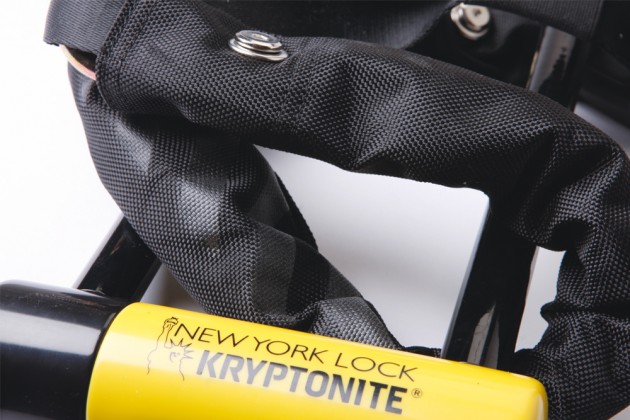
Who is Sold Secure?
Sold Secure is an independent certification testing house dedicated solely to testing lock security. Established by the Home Office in 1992, it is based in the UK and is now a not-for-profit organisation that invests any profits in supporting police and crime prevention initiatives.
This position enables Sold Secure to respond swiftly to evolving techniques by collaborating with the police and even reformed thieves while maintaining impartiality. Sold Secure also serves as a valuable resource, offering advice to brands during the development of new locks.
If you would like to learn more about Sold Secure, Tech Writer Hannah has interviewed Guy McCaffery, the lab manager, and key figures from brands like Abus to understand how Sold Secure benefits riders.
What do the Sold Secure ratings mean?
Sold Secure grades based on resistance to specific tools and techniques, broken down into four levels to determine overall security. Sold Secure understandably does not specify which tools but it does give this outline:
Sold Secure Bronze - Offers resistance against basic tools, which should prevent opportunist criminals.
Sold Secure Silver - should offer greater resistance against more heavy-duty tools, this is aimed at balancing enhanced security and cost.
Sold Secure Gold - Looks to prevent dedicated thieves and stop bikes from being stolen in quieter locations and usage of more aggressive tools.
Sold Secure Diamond - This is the highest level of security and the only one to cover e-bikes. Specialist tools in this testing could include angle grinders.
Do I need bicycle insurance?
Unfortunately, perfectly secure bike locks simply don’t exist; With the right tools, expertise and determination, anyone can get through any lock.
As such, it is important to ensure you have the support of the best bicycle insurance companies If your bike is stolen, you are at least not out of pocket. Be sure to check the small print when you take out a policy, most bicycle insurers will require a certain level of lock security.
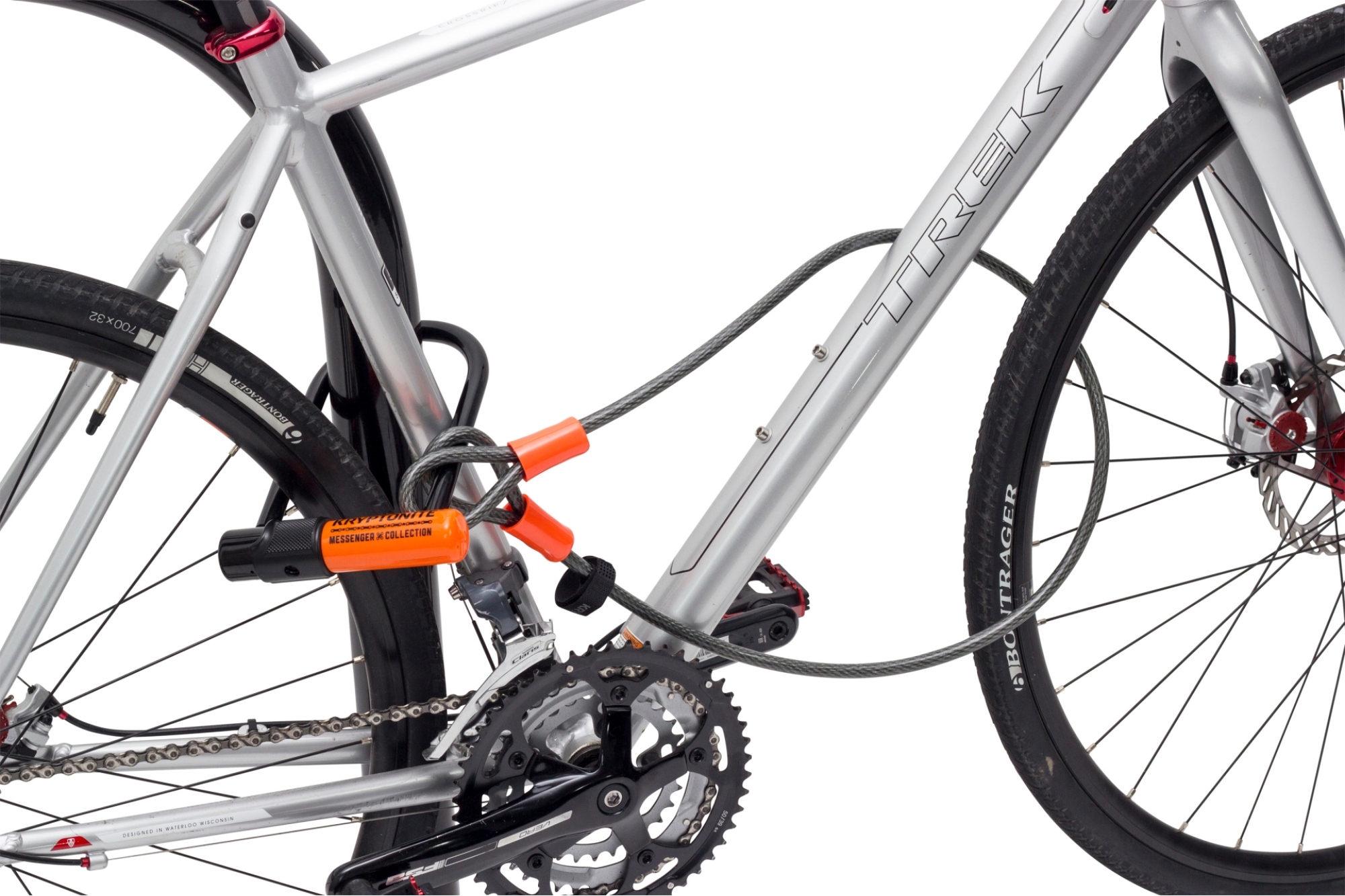
kryptonitelock.com
How do I lock my bike securely?
In an ideal world, you shouldn't feel the need to worry about your bike not being there on your return, unfortunately, the reality is very different. The recommendation is to use two highly-rated locks, one to secure the front wheel and frame and a second for the rear wheel and frame.
A pragmatic approach of carrying two heavy high-security locks and two sets of keys would be a real faff. So, ideally, as I have said above buy the best lock you can afford or invest in additional security like a tracker.
At the very least you should secure a fixed part of your bike like the frame to a non-movable feature, like an N-shaped bike rack. If your bike is fitted with thru-axles wheel security is less of an issue, but you can secure your wheels with a cable extension or by passing your lock through your wheels along with your frame. You could also do this with a second lighter-weight or lower-rated lock.
For a more in-depth guide on securing your bike, check out Eight ways to Secure Your Bike by Paul and Kat.
How else can I secure my bike?
Assuming you have followed our eight tips for keeping your bike safe, there are some additional things you can do:
For older bikes or those that use quick-release wheels and seat clamps, the obvious solution is to swap to a set of security skewers. For thru-axle bikes remove any handles or take a look at the the Hexlok system.
While the market is still in its infancy for those with a sentimental attachment to their bike or who would rather not rely on insurance, GPS bike trackers and Apple Airtags are worth considering. Just whatever you do let the police track your bike down, don't do it yourself.
Maybe even consider some extra home security tech like Ring or Blink Bells and cameras.
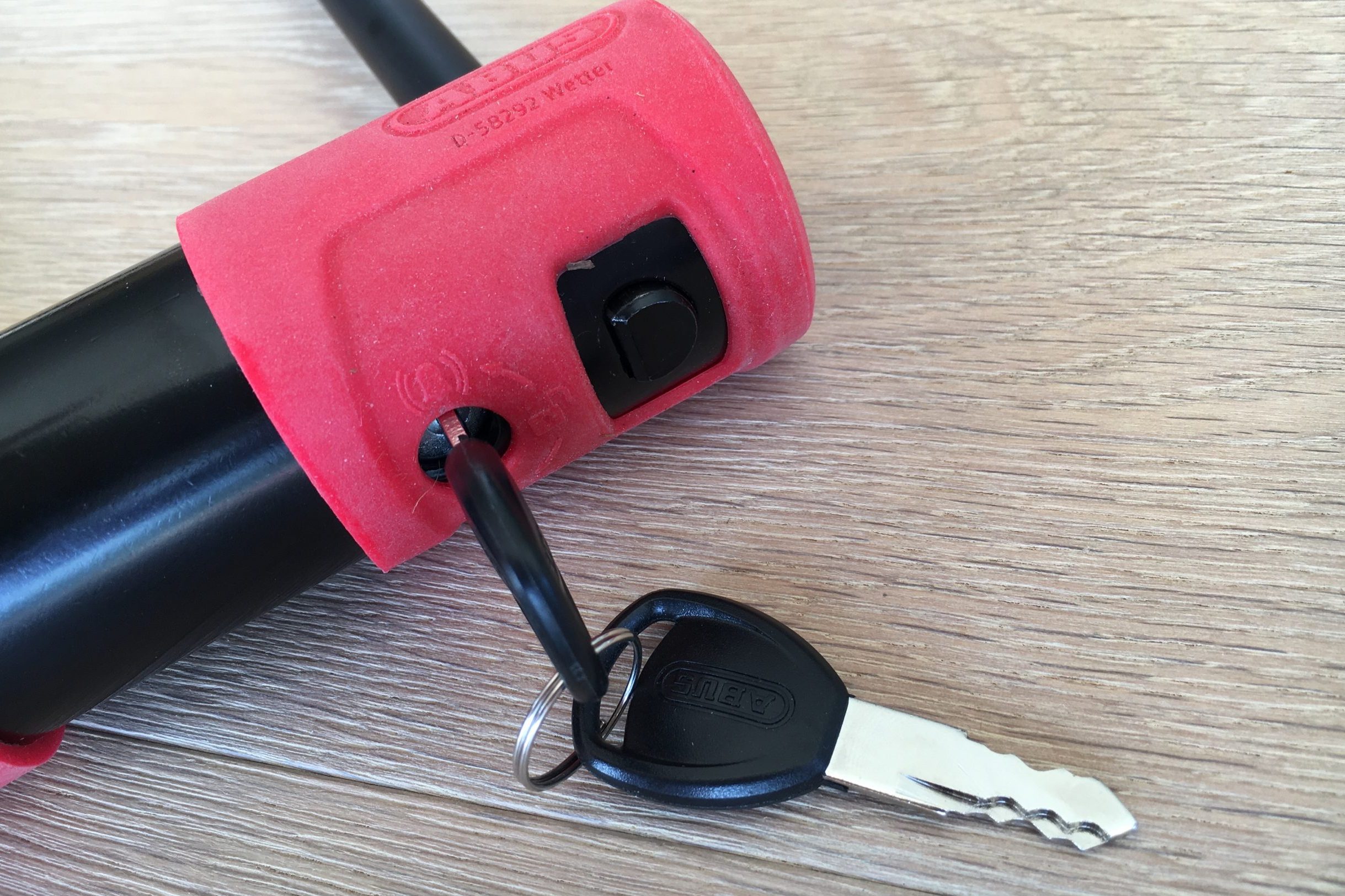
How do I maintain a bike lock?
There is a lot of advice on this particular subject, but maintaining a bike lock is very simple. You should do it regularly to ensure a perfectly working mechanism, particularly when it's wet and cold.
1. Clean any contact points between the shackle and the lock barrel to avoid any corrosion build-up.
2. Using WD-40/GT85 (a water dispersant), ensure all the moving parts, including the shackle security and lock barrel, are moisture-free. Turning the key after application will help work the dispersant into the unseen areas.
3. Once the dispersant has worked its magic, apply a small amount of lubricant to the lock barrel and shackle. I recommend a good-quality bicycle wet lubricant, like Muc-Off's wet lube or Peaty's link lube. This is basically something that cannot be easily washed away.

Is there a bike lock that cannot be cut?
My testing of the best angle grinder-resistant locks proved that even those designed to be highly resilient can still be cut through. That said, making any headway is very difficult and requires a lot of time and grinder discs. The likely scenario here is that the thief will give up and move on.
It is worth remembering, though, that if a lock is not angle grinder-resistant, it can become very easy to cut through, and a thief can be through in a matter of seconds.
What bike locks are police approved?
Police-approved bike locks are generally those rated highly by an independent testing house like Sold Secure or Secured By Design, which actually works directly with the Police.
It requires a separate approval process, during which the Police scrutinise the independent testing and provide secondary reassurance that a bike lock is secure, quality, and reliable.
There are a number of police-approved locks in the UK, and you can find a list of these on the Secured By Design website.
Bike Lock Glossary
- Lock Barrel - Part of a bike lock's anatomy that houses the security lock, which is typically actuated by a key. The lock barrel is located in different places depending on the lock's style. For example, in a U-lock, the lock barrel makes it look like a D-shape when locked.
- Shackle - For many, this is the U-shaped part of a U-lock's anatomy, used to secure your bike to a static object. This term is sometimes extended to others, such as the interconnected links of a folding lock.
- Reach is typically measured in the width and length of a lock. This should show you how far your bike can be from the static object you are trying to secure it to. Just remember to factor in the object and your bike's frame diameters. With chain and wearable locks, we typically list the overall length or circumference.
- Lockable Area - This figure we mentioned sporadically in our reviews but is used to give a better understanding of how big a lock is versus others on review. This is typically done using a stand Area2 formula of length X width
- Combo Lock - An abbreviation of the term used when a lock employs a combination to secure it versus a key.
The latest race content, interviews, features, reviews and expert buying guides, direct to your inbox!
Like many, Matt began his bicycle industry journey on the spanners at his local bike shop. After spending his youth mountain biking, he was inspired to embrace gravel during his tenure with Evans Cycles' in-house brands, Pinnacle and Hoy Bikes. Recognising the evolving industry, Matt eagerly seized the chance to become an E-bike designer, winning several awards with the E-bike brand Cairn Cycles.
These days, Matt is likely to have a toddler sitting shotgun or off the beaten track somewhere on the South Downs.